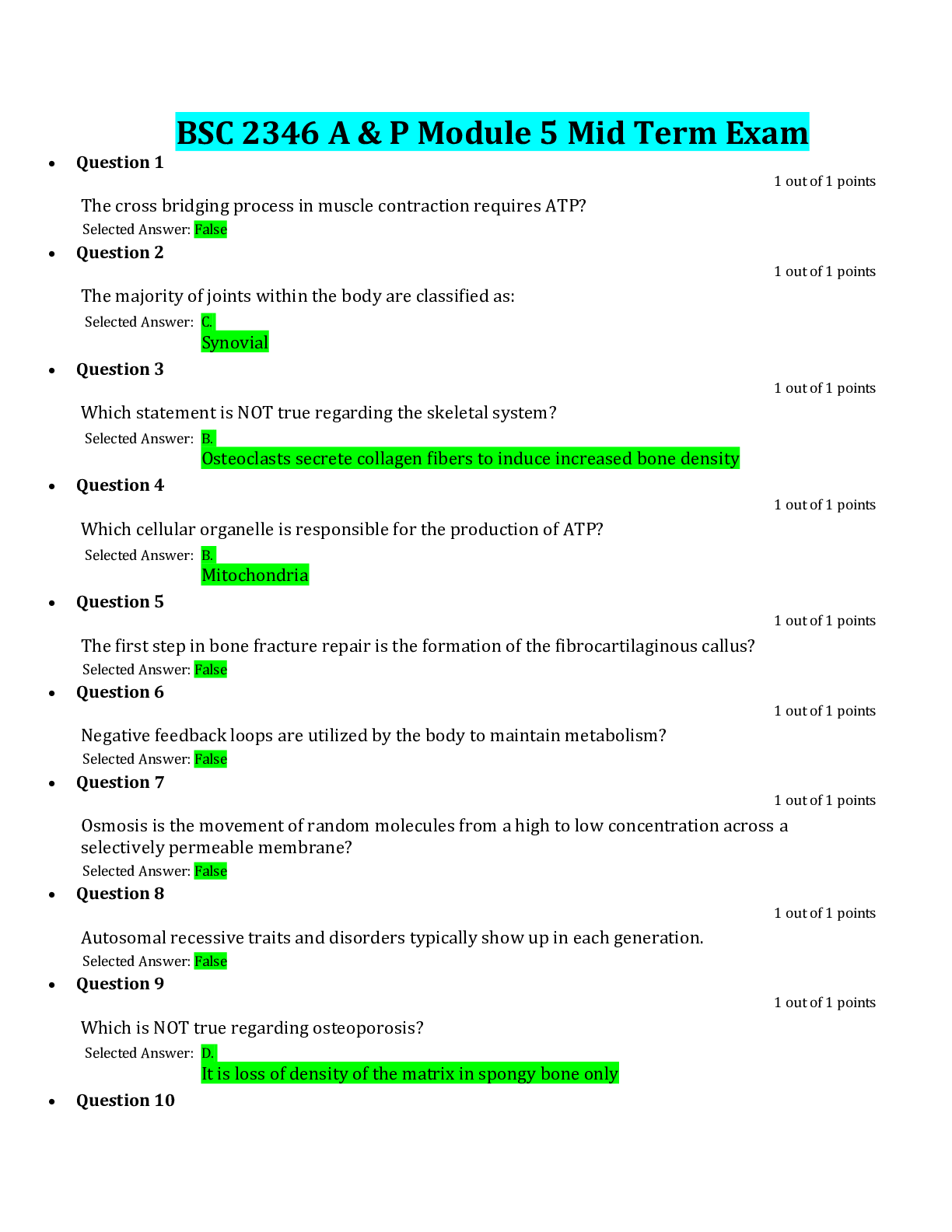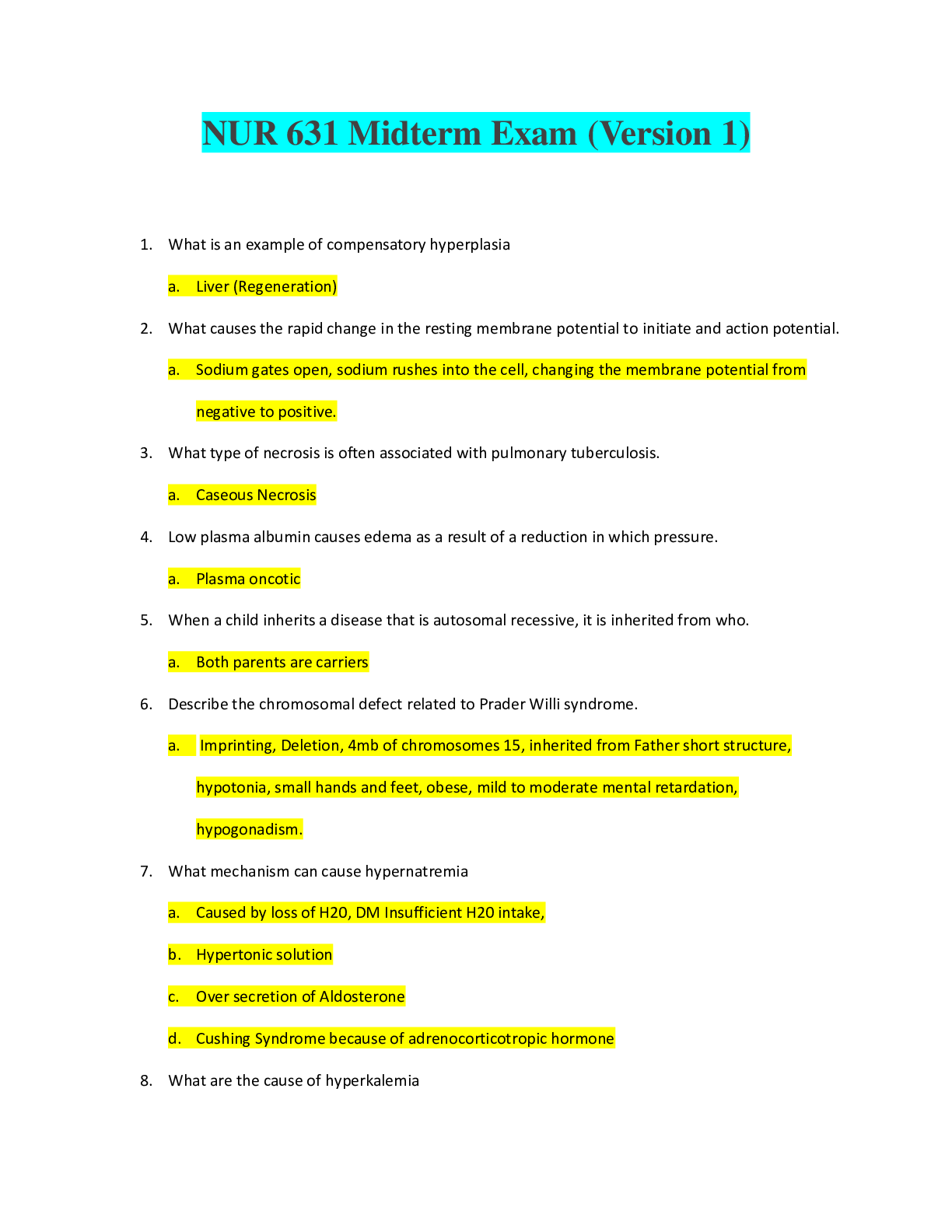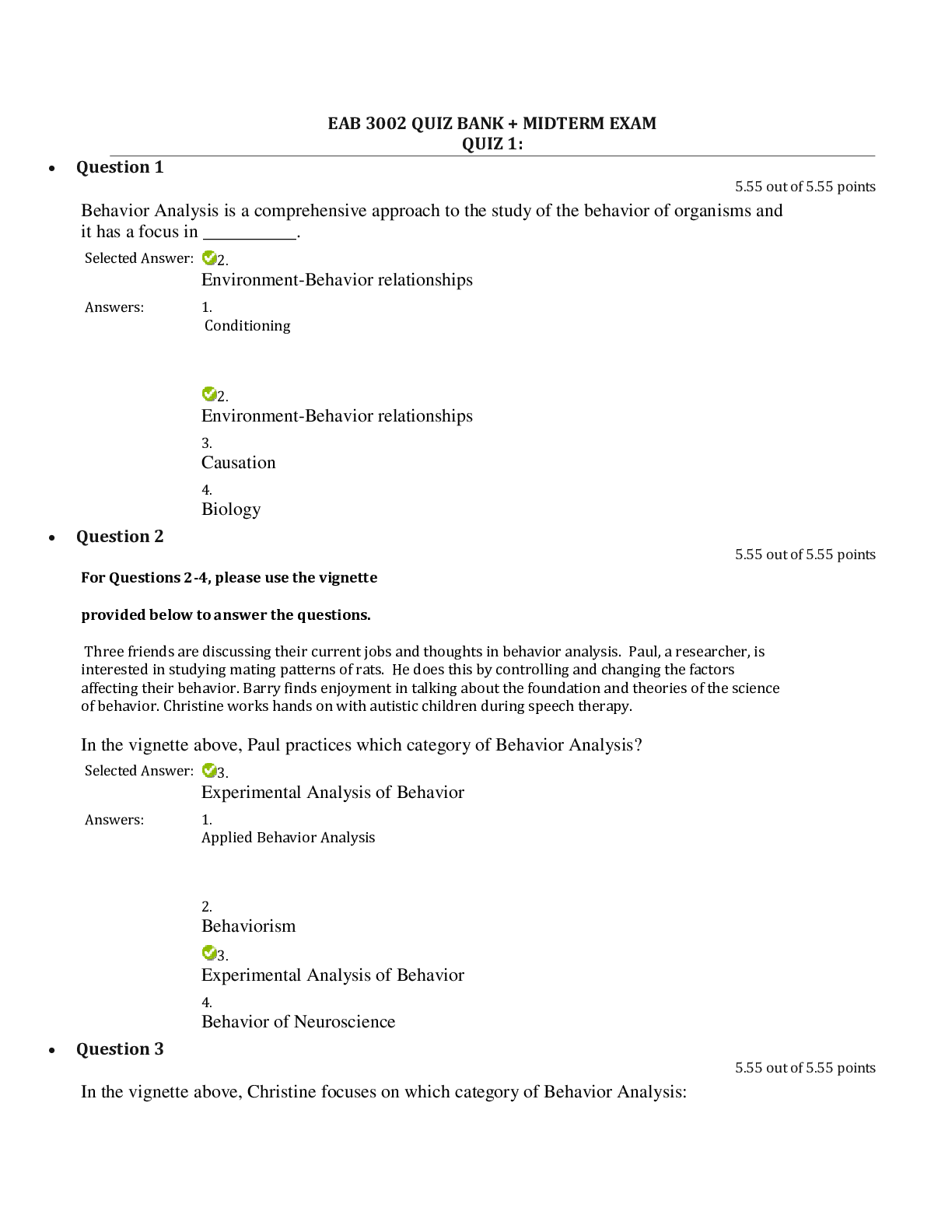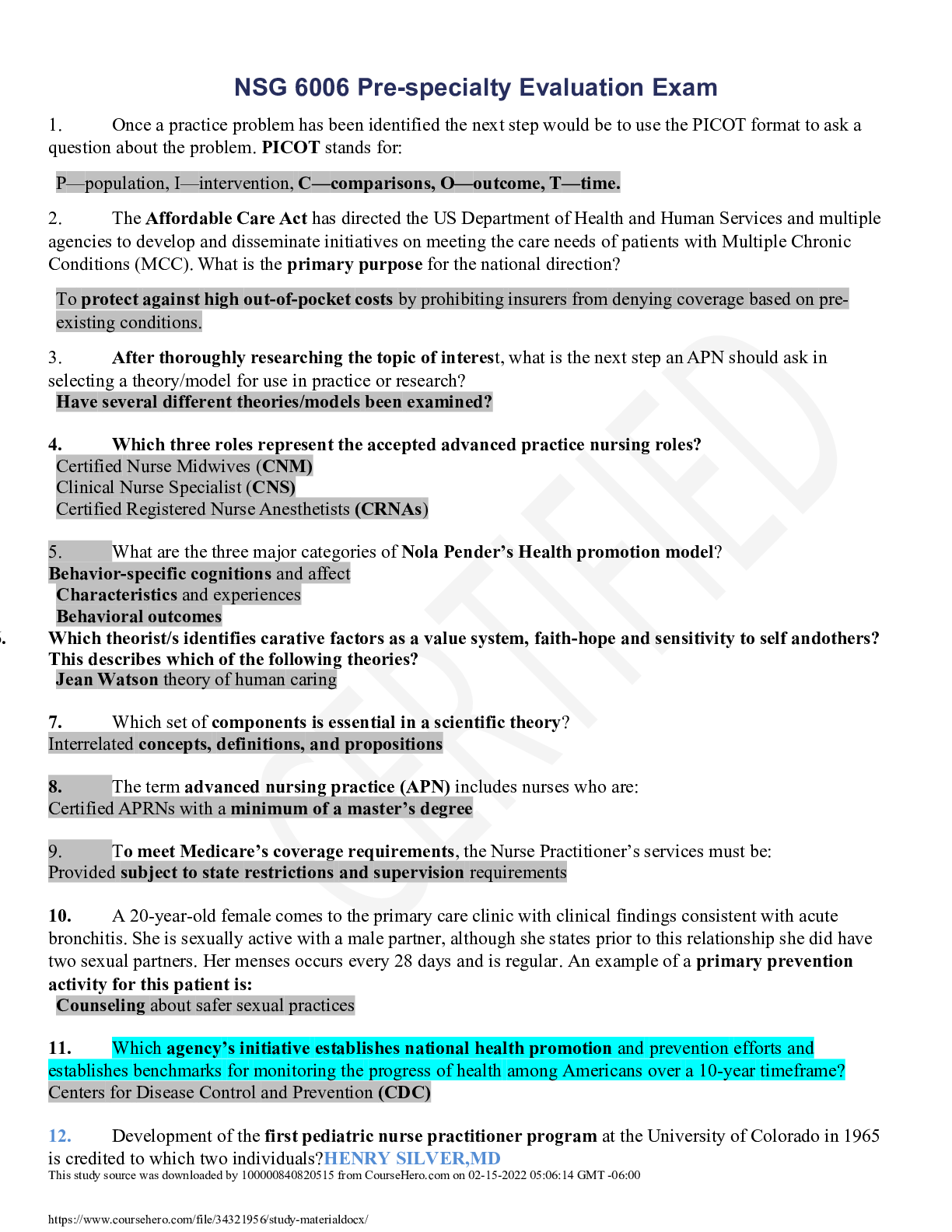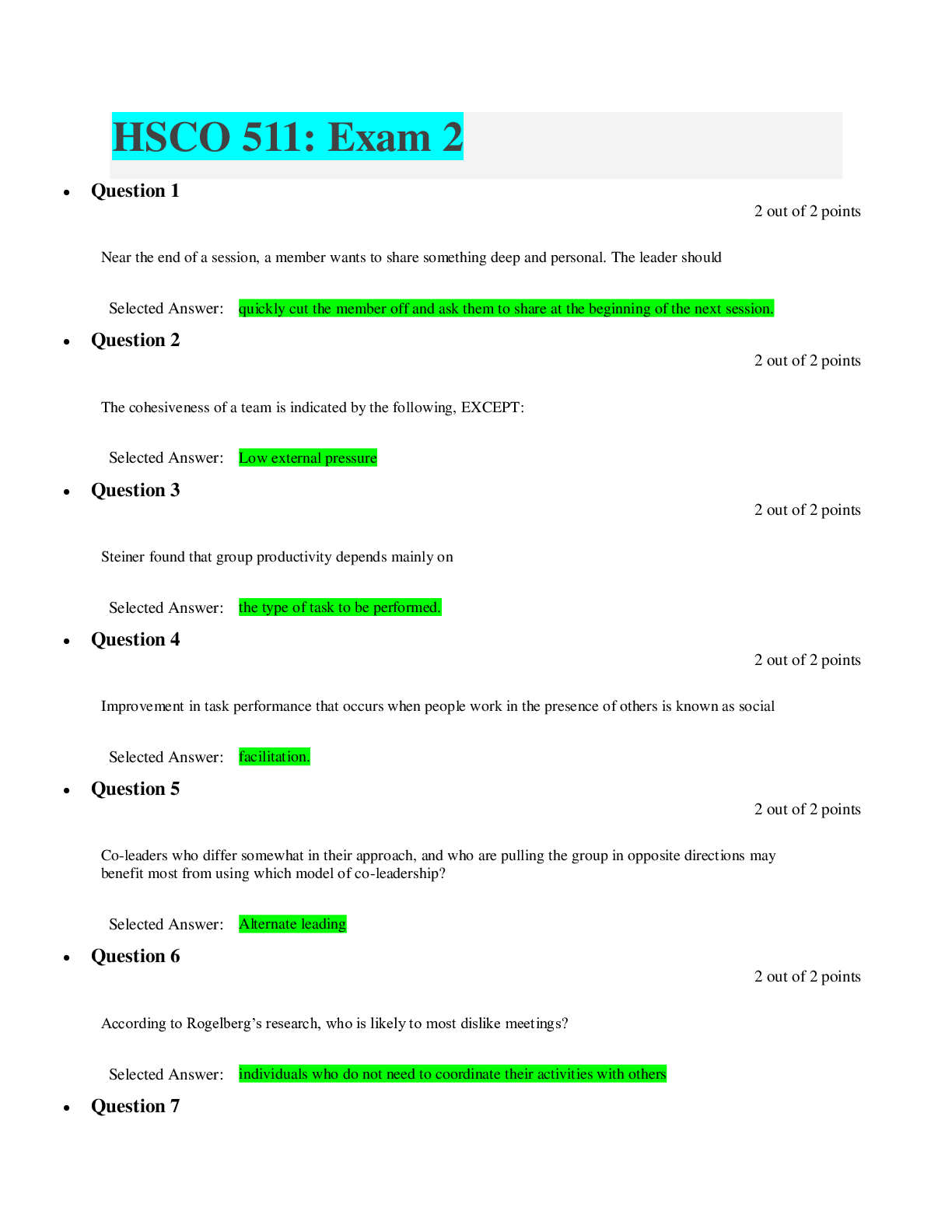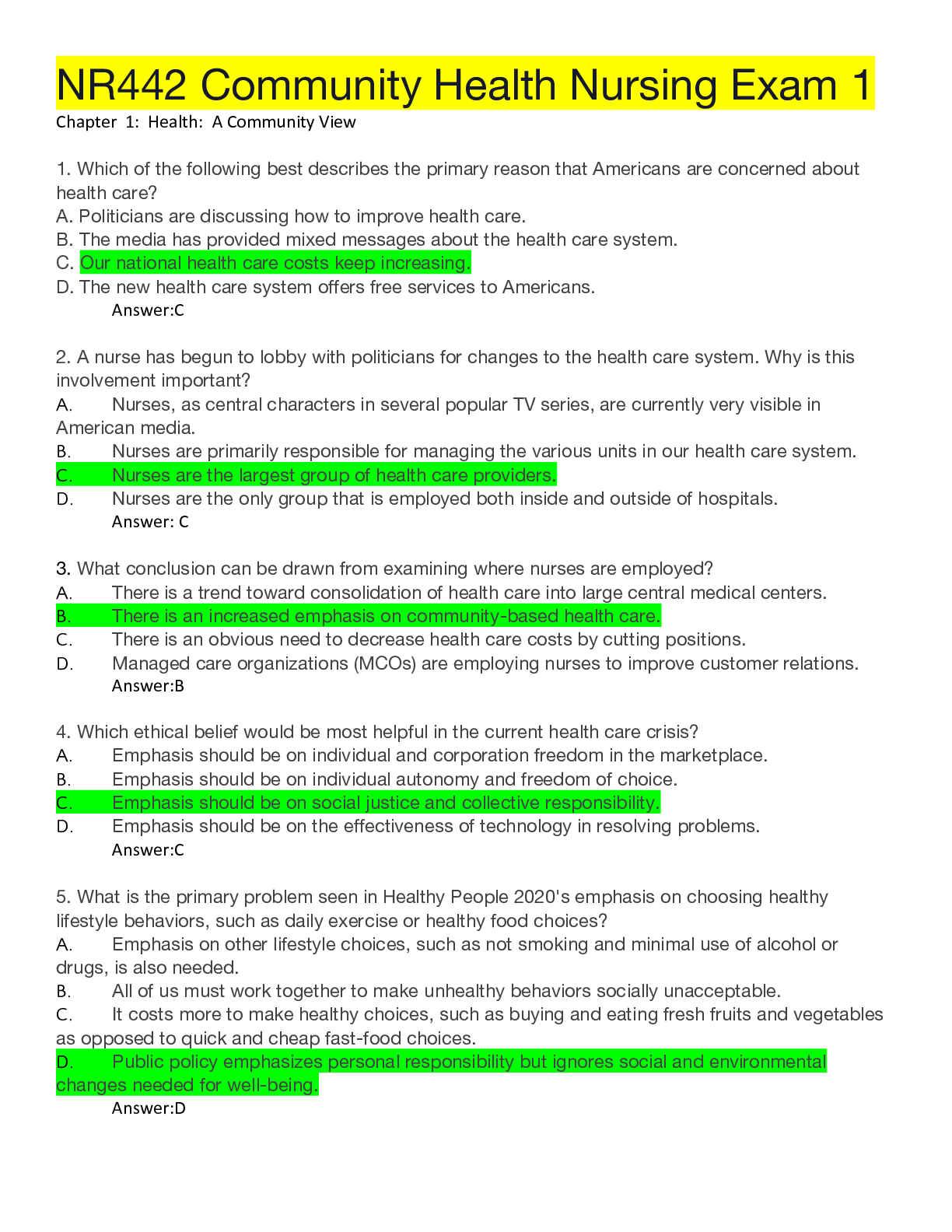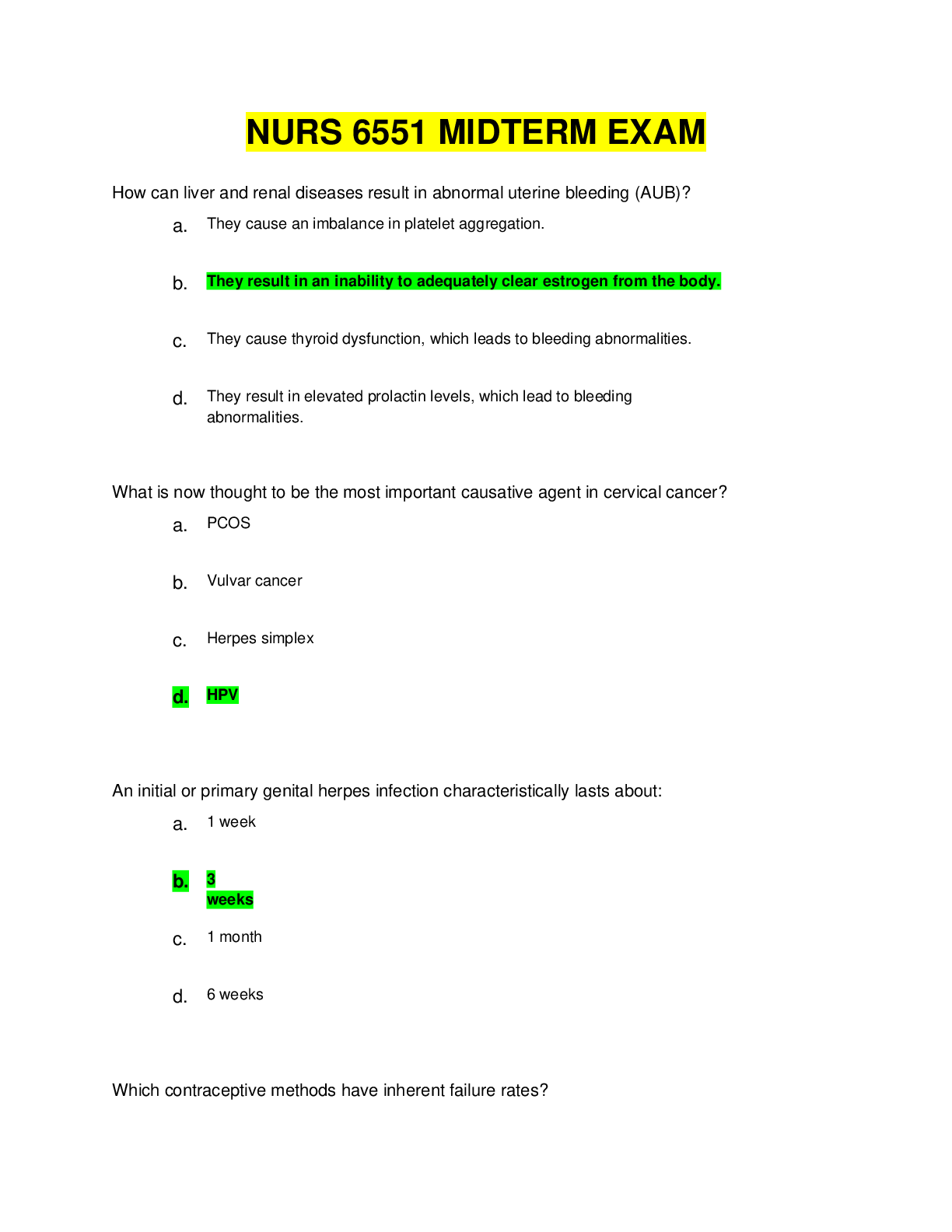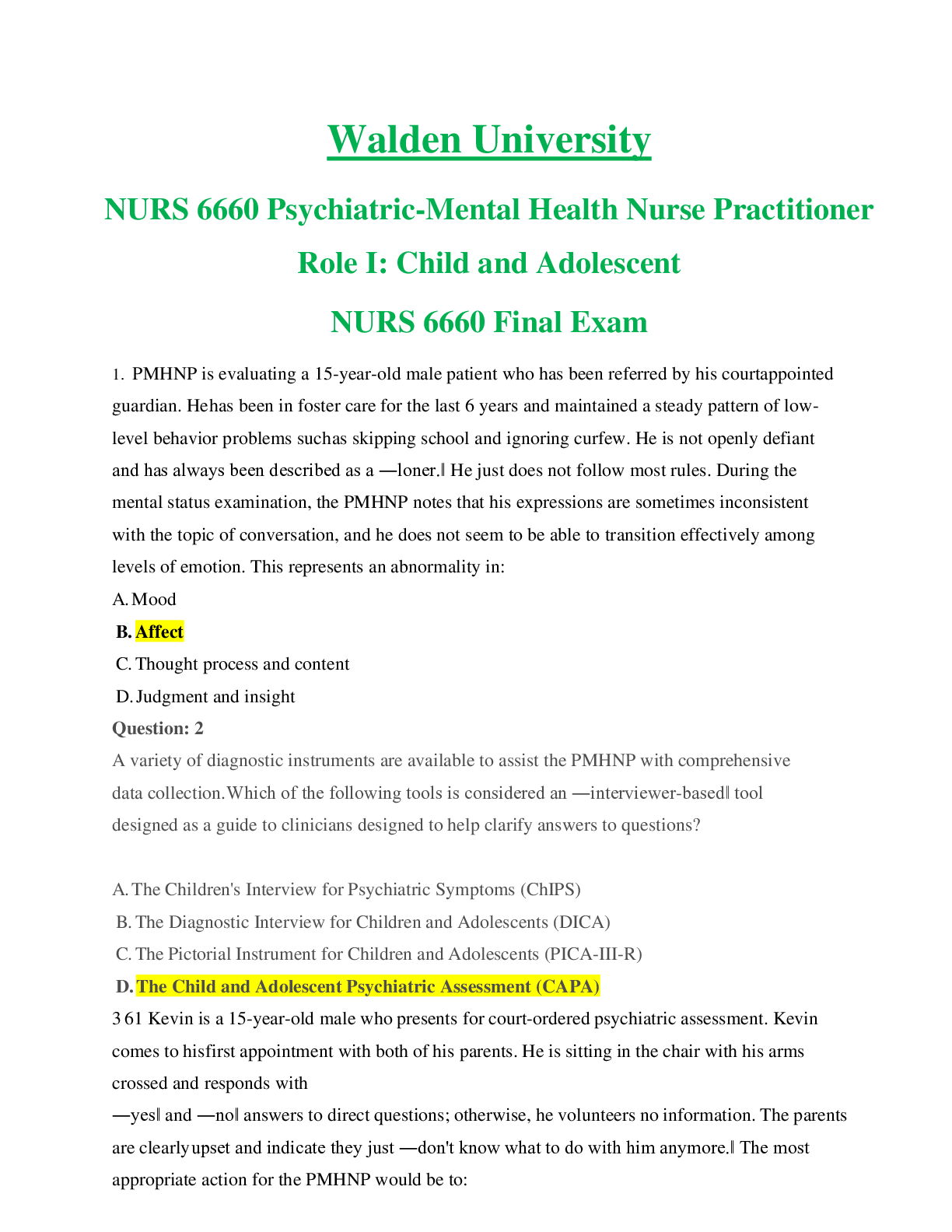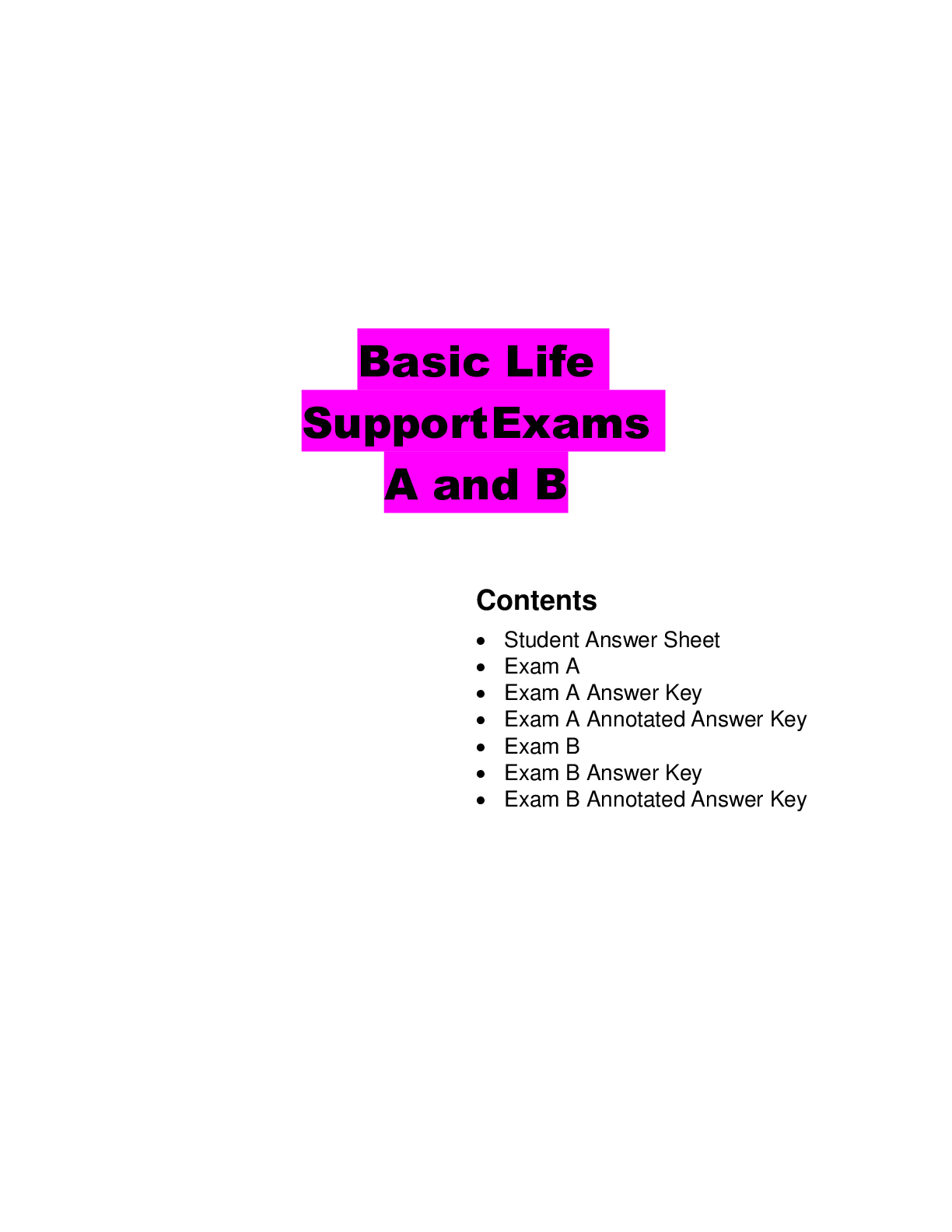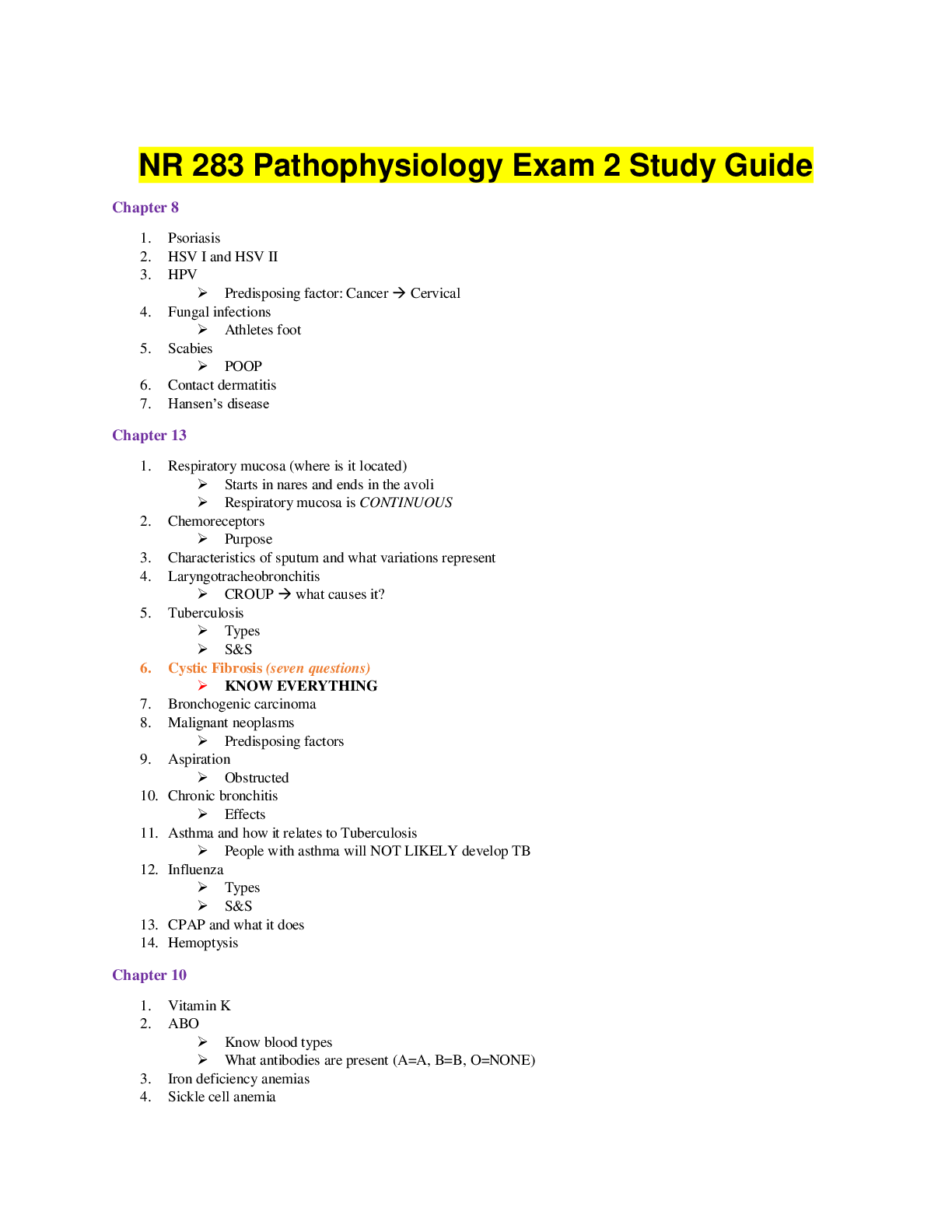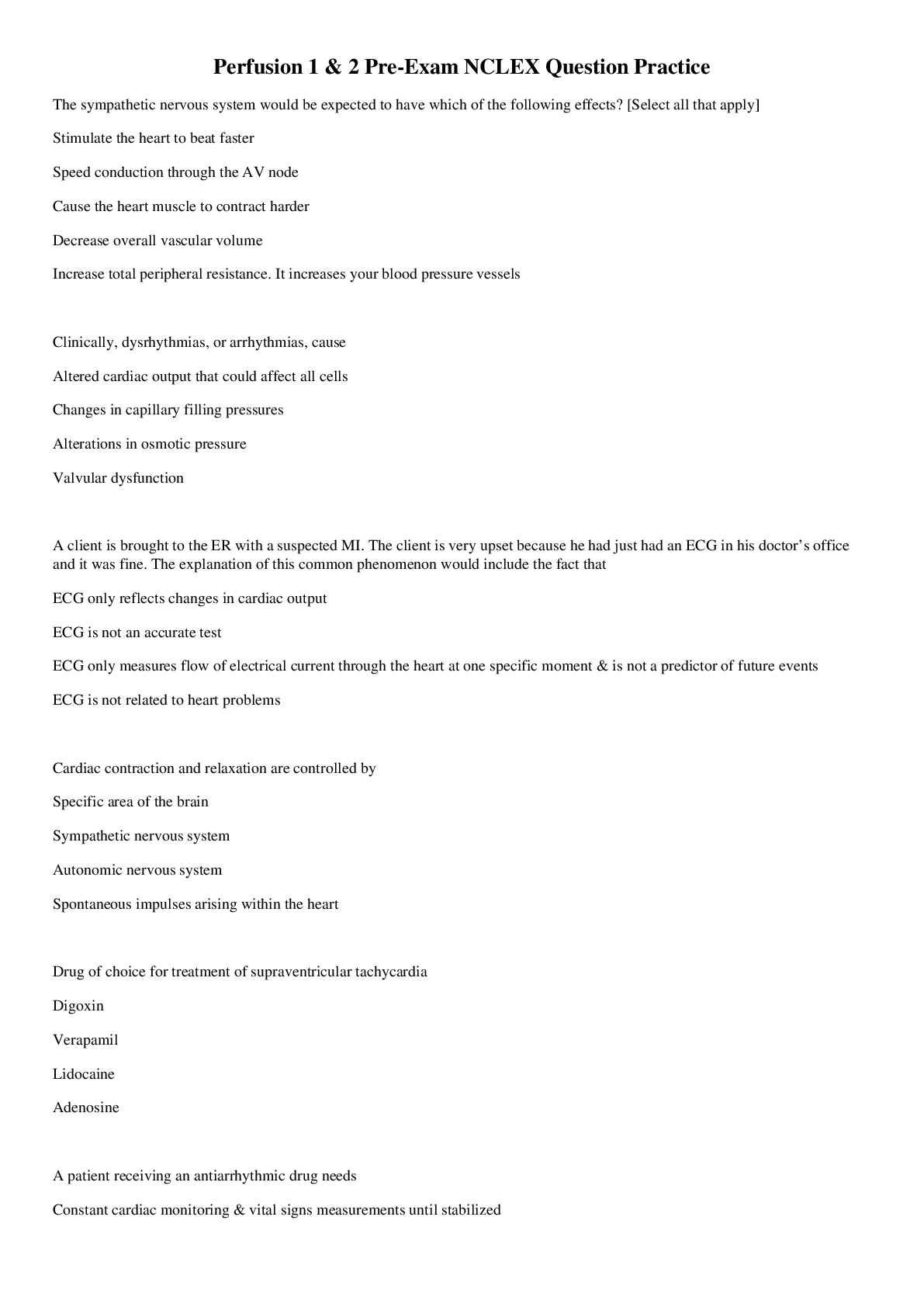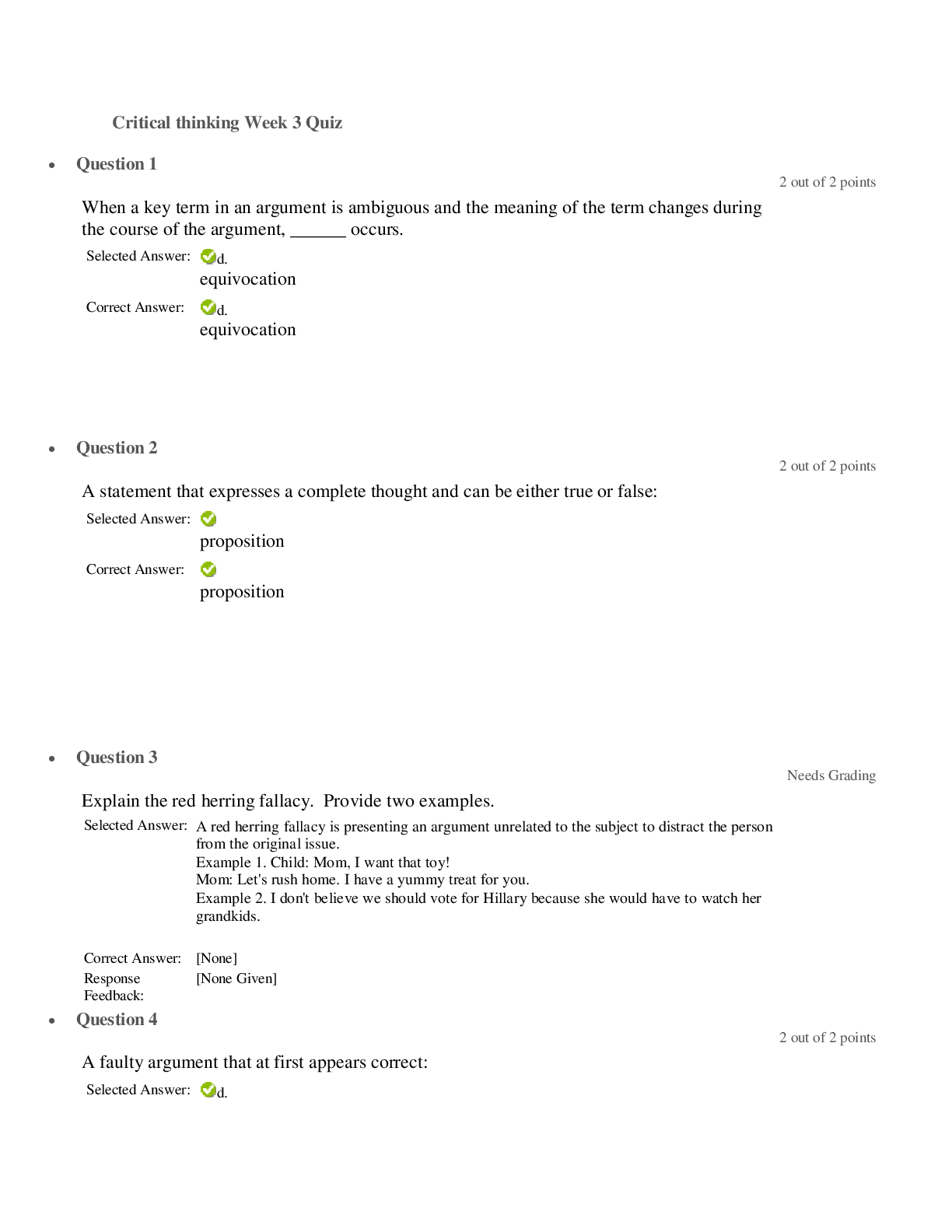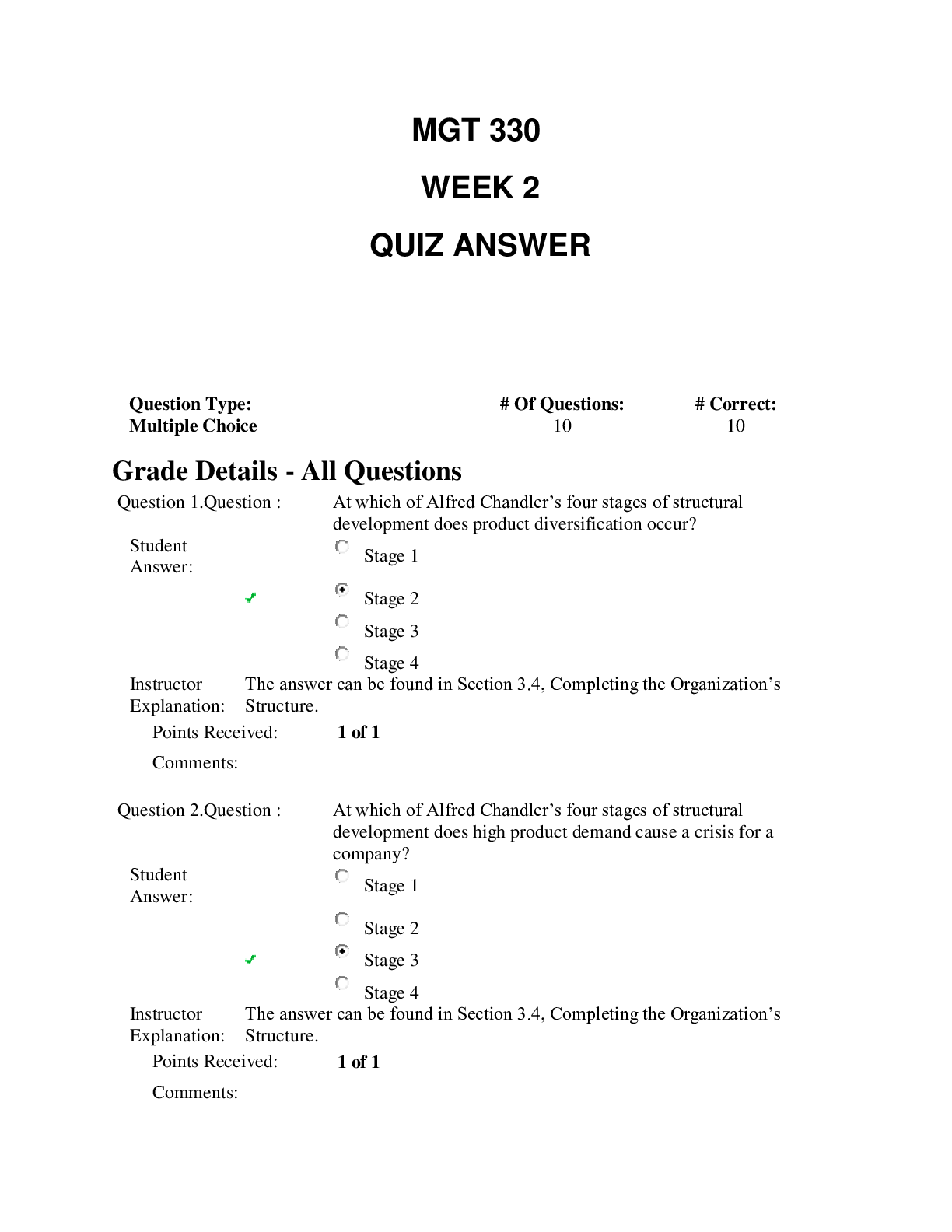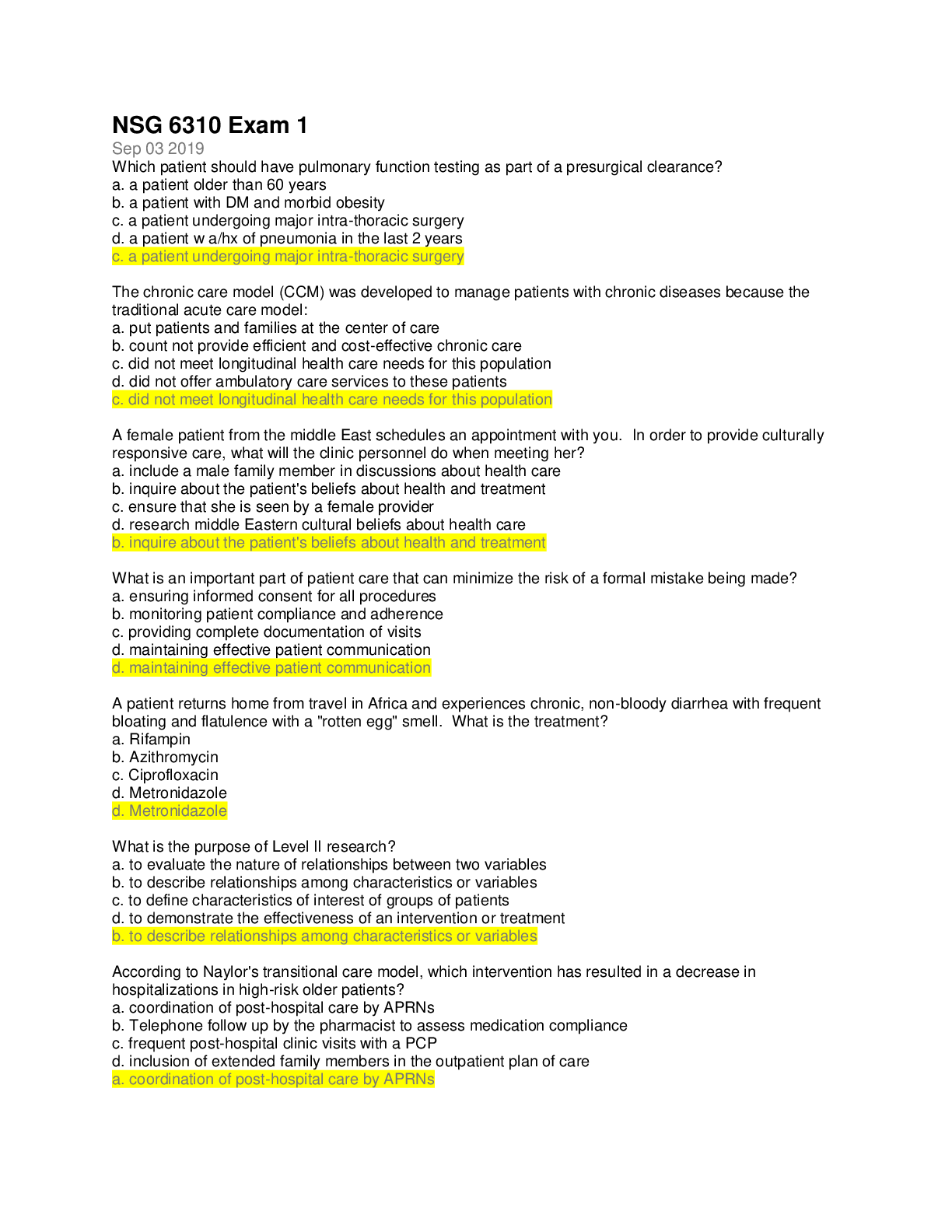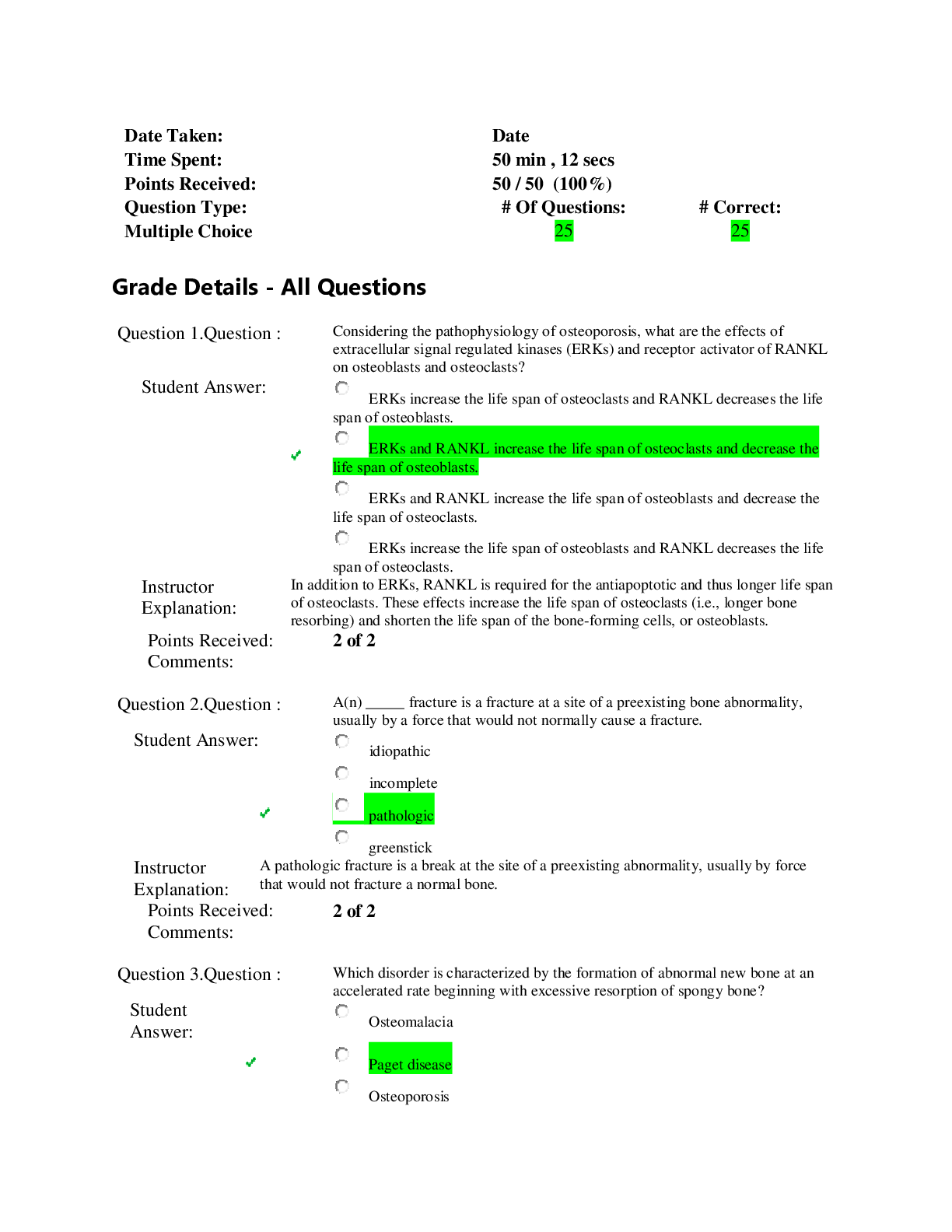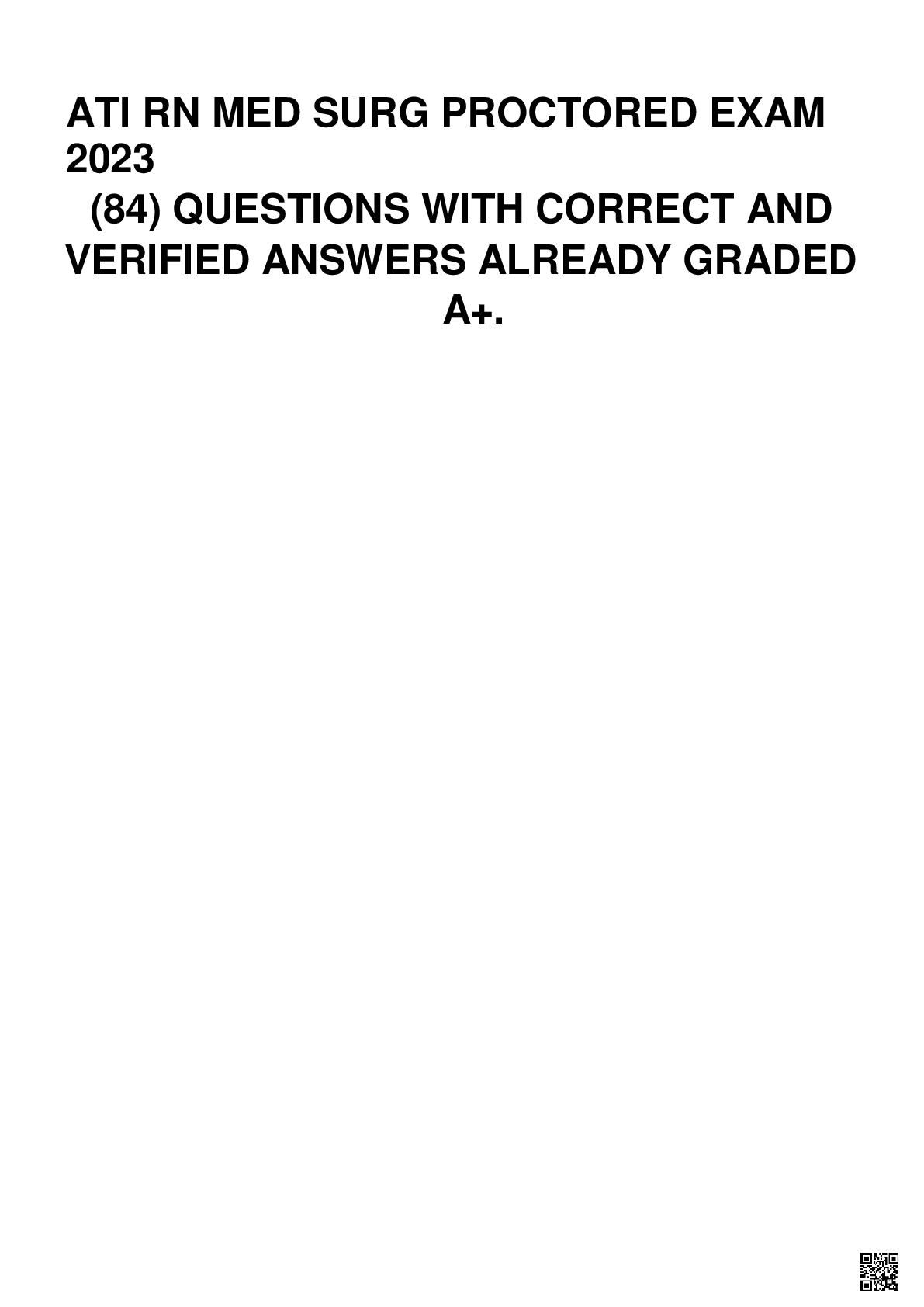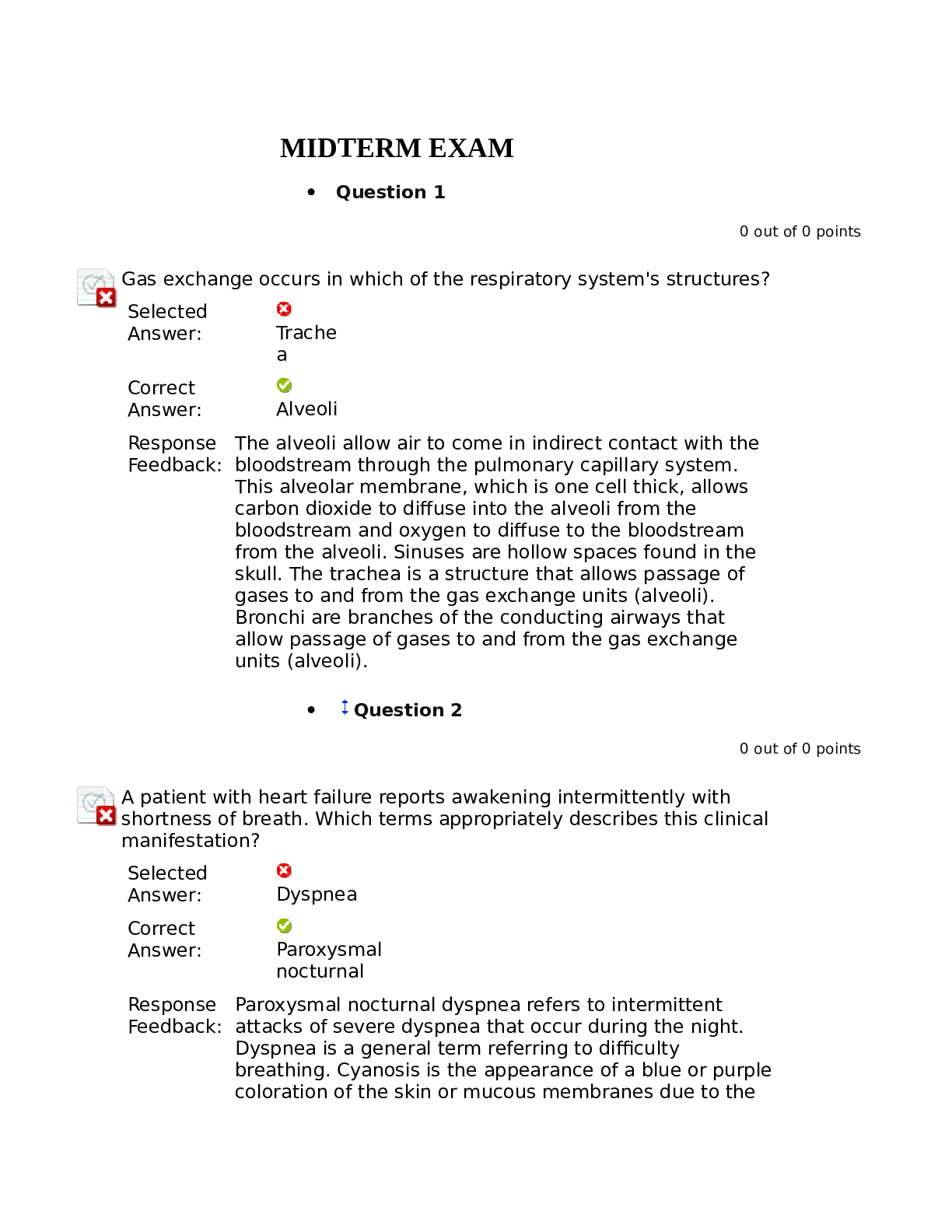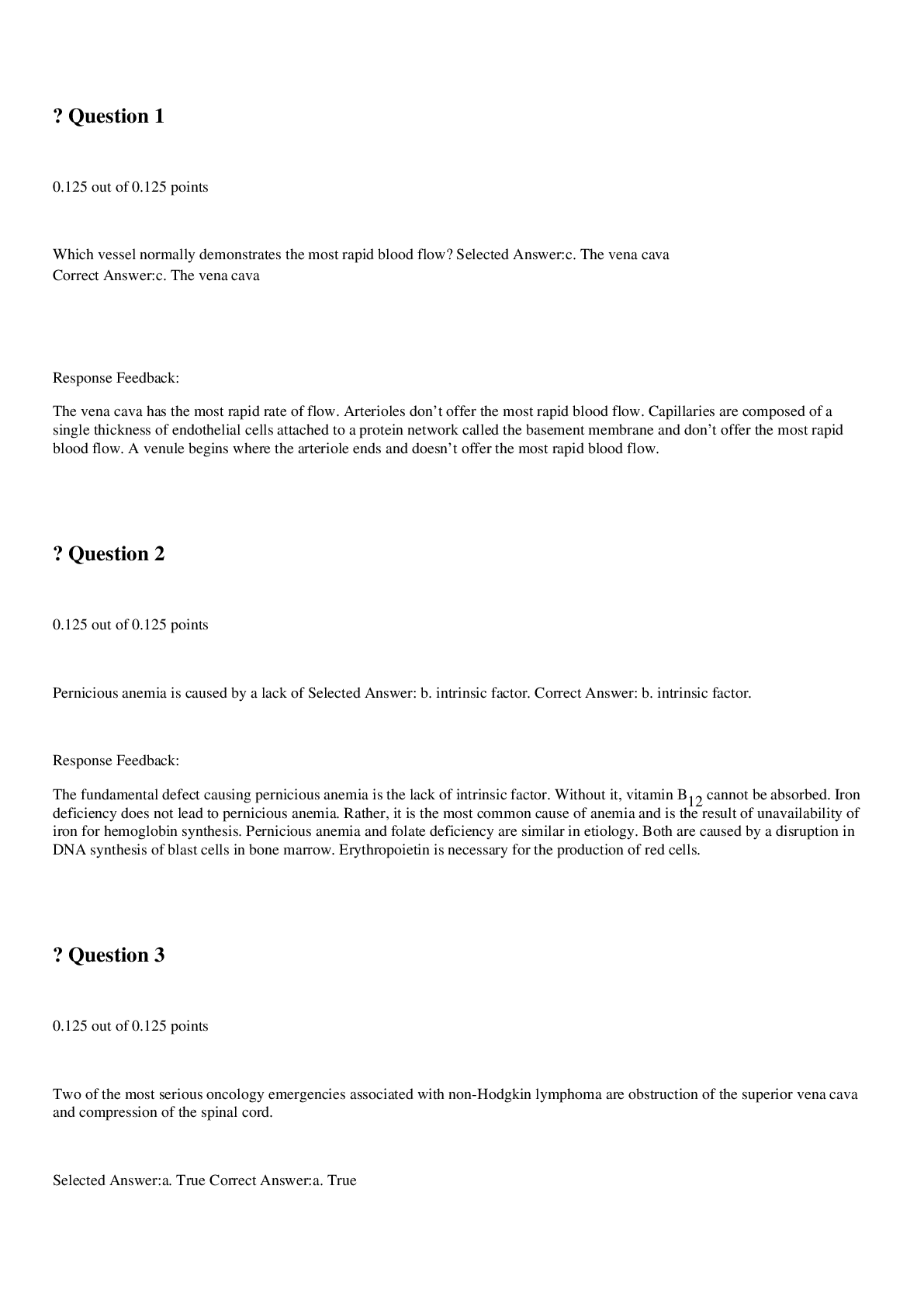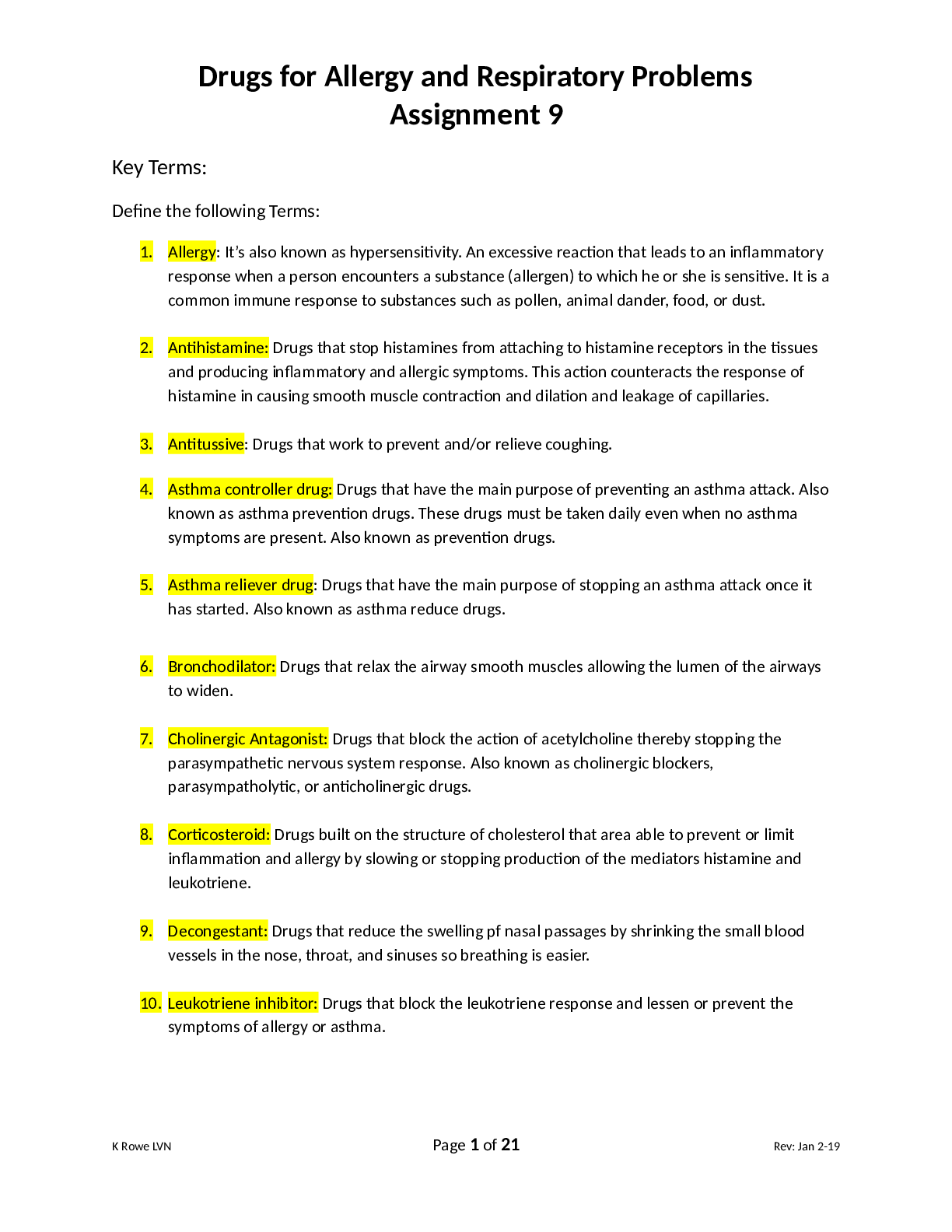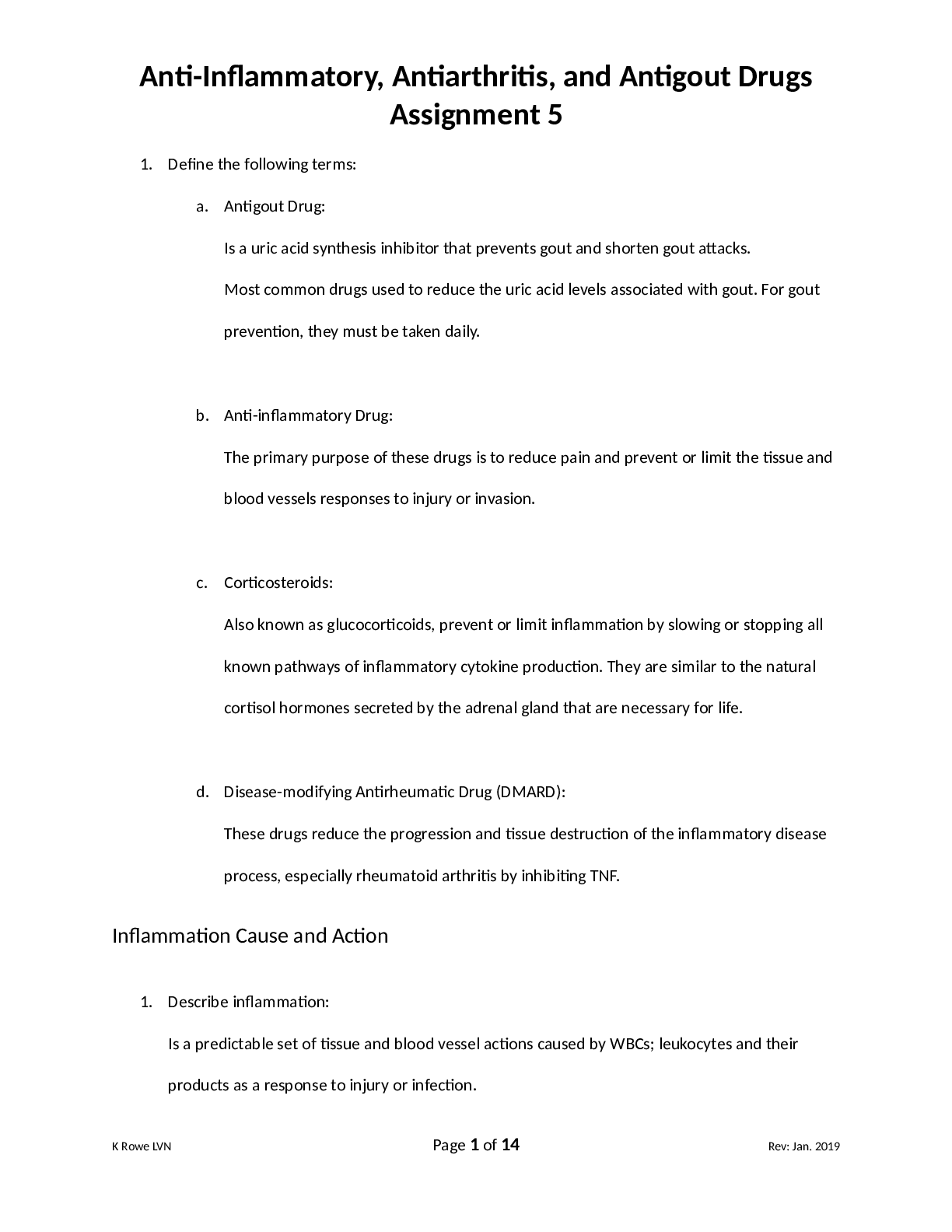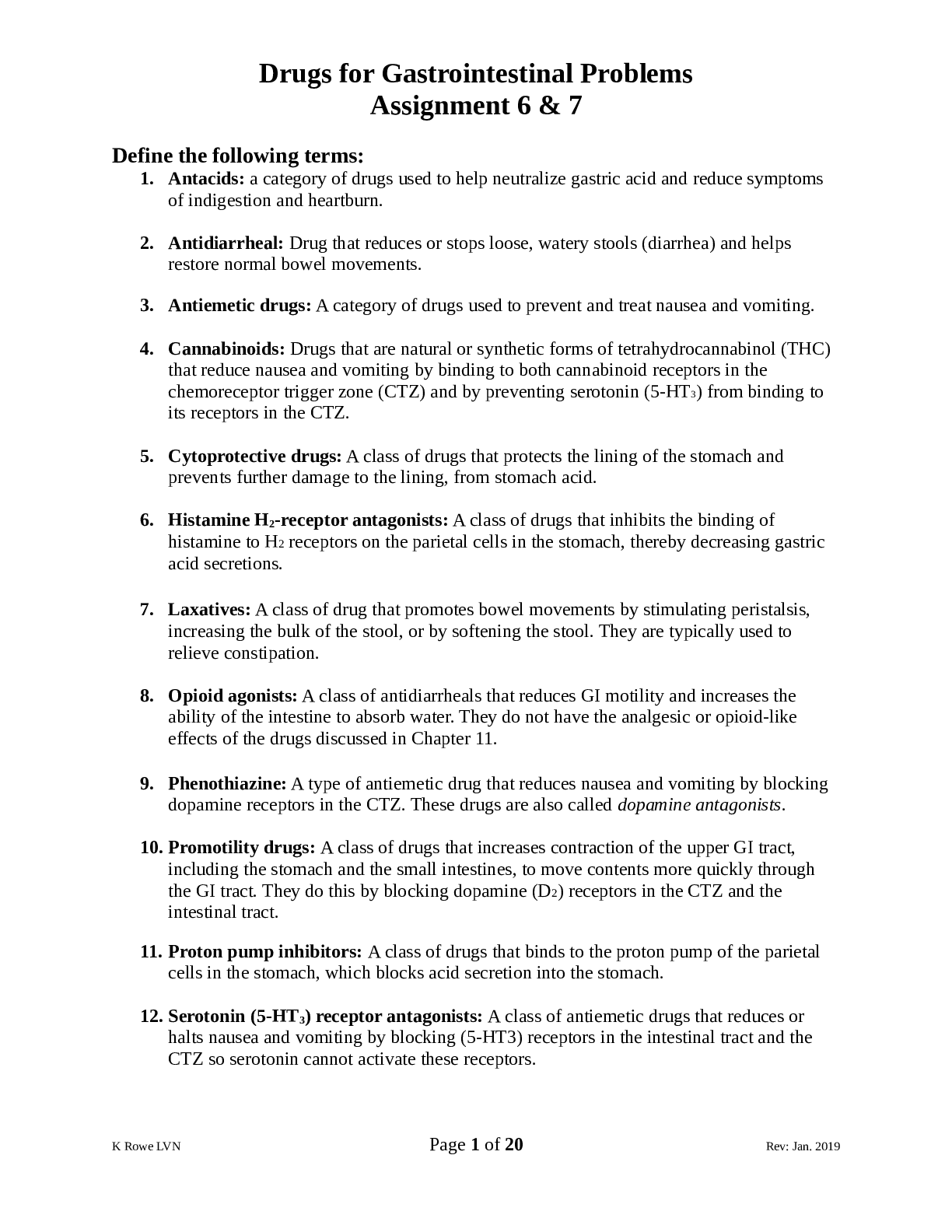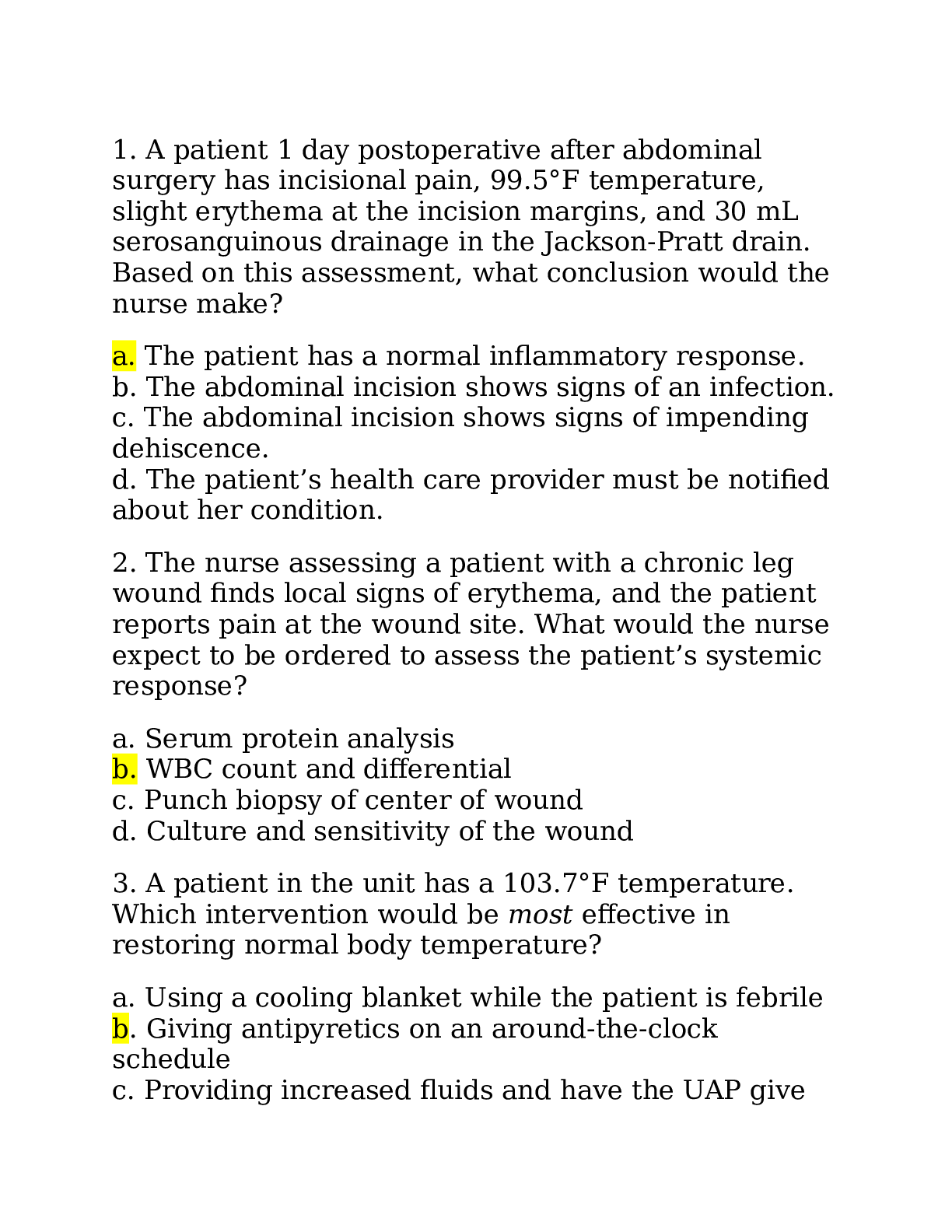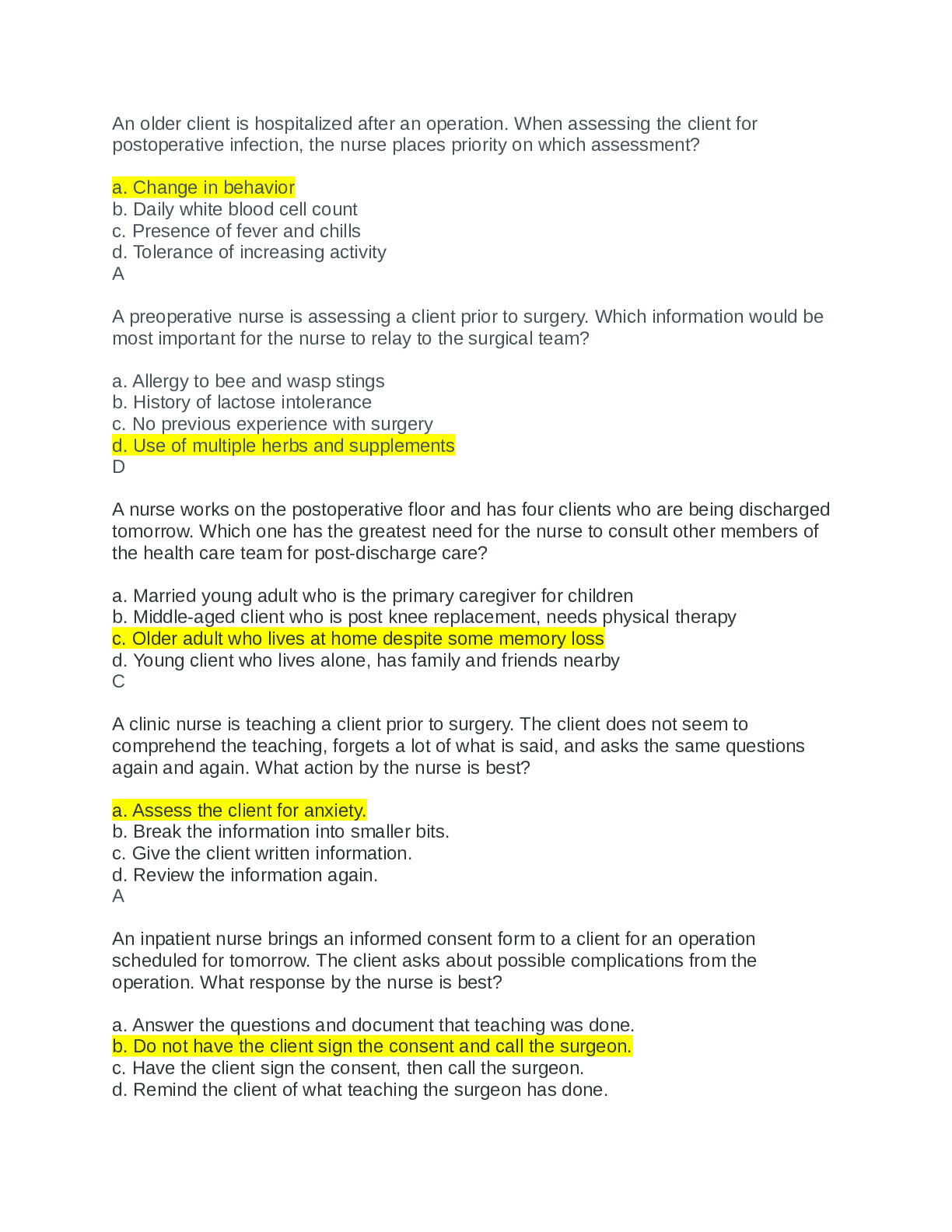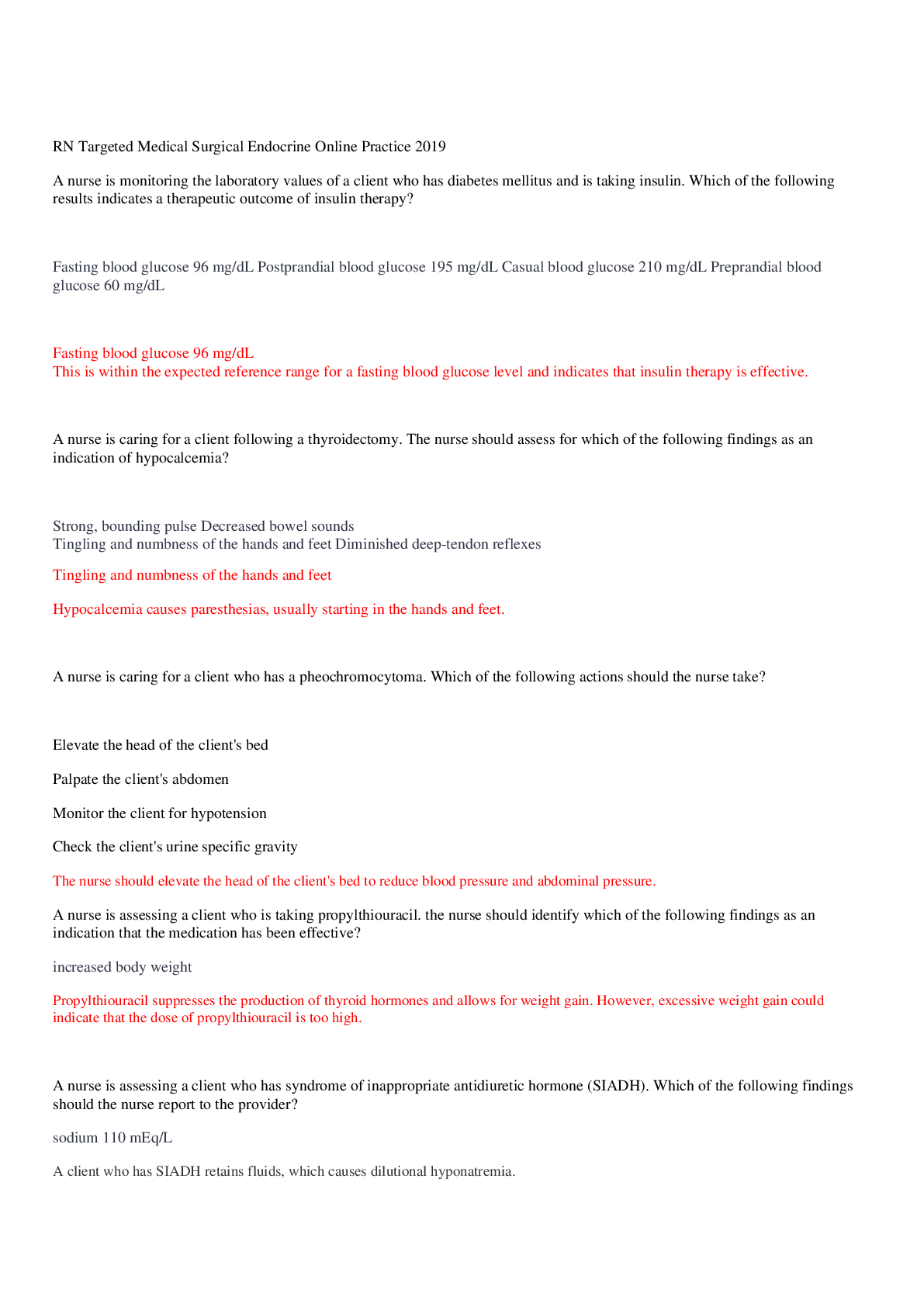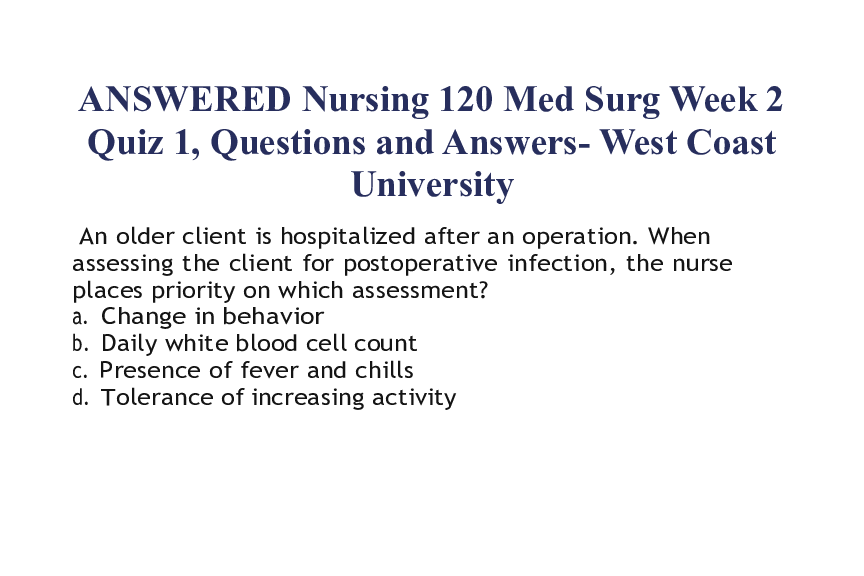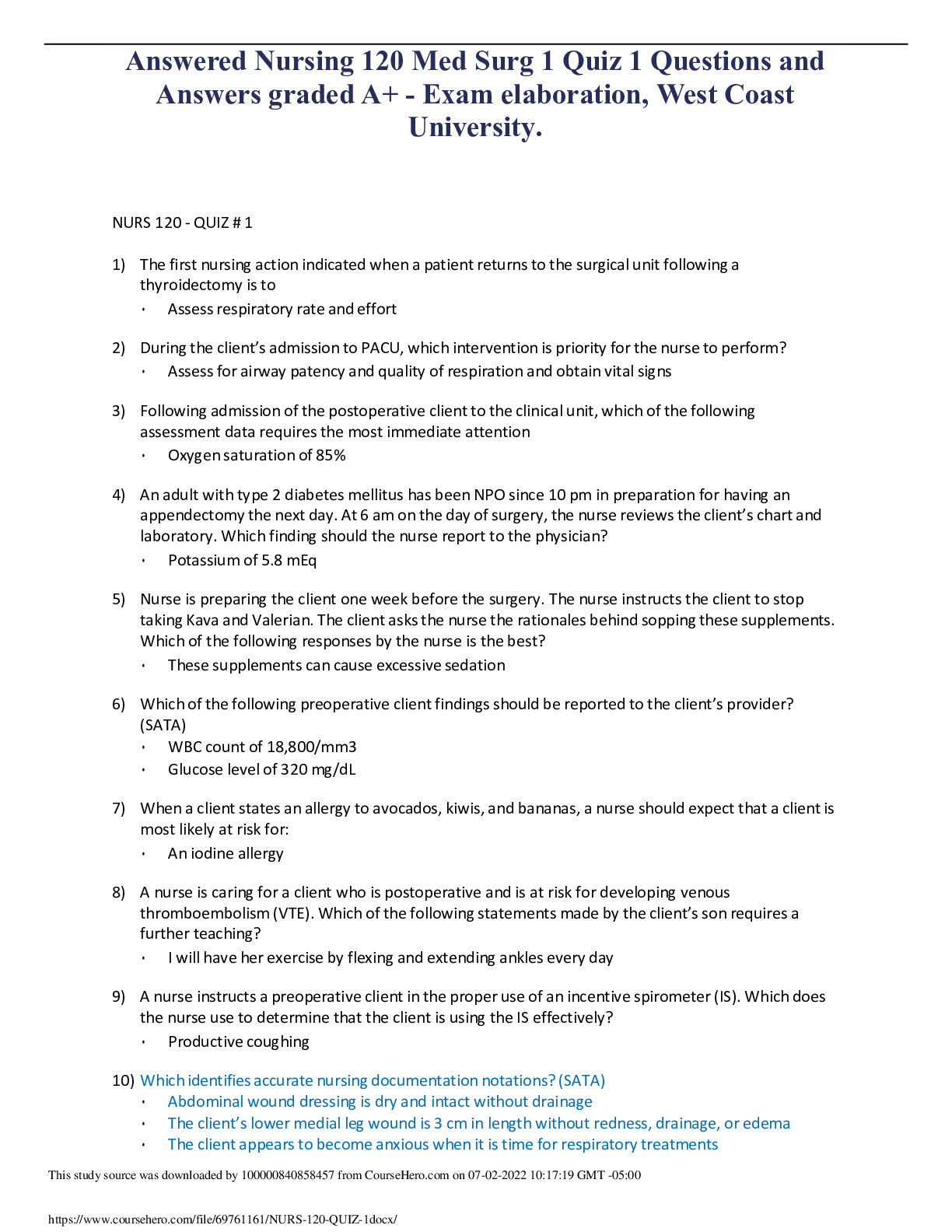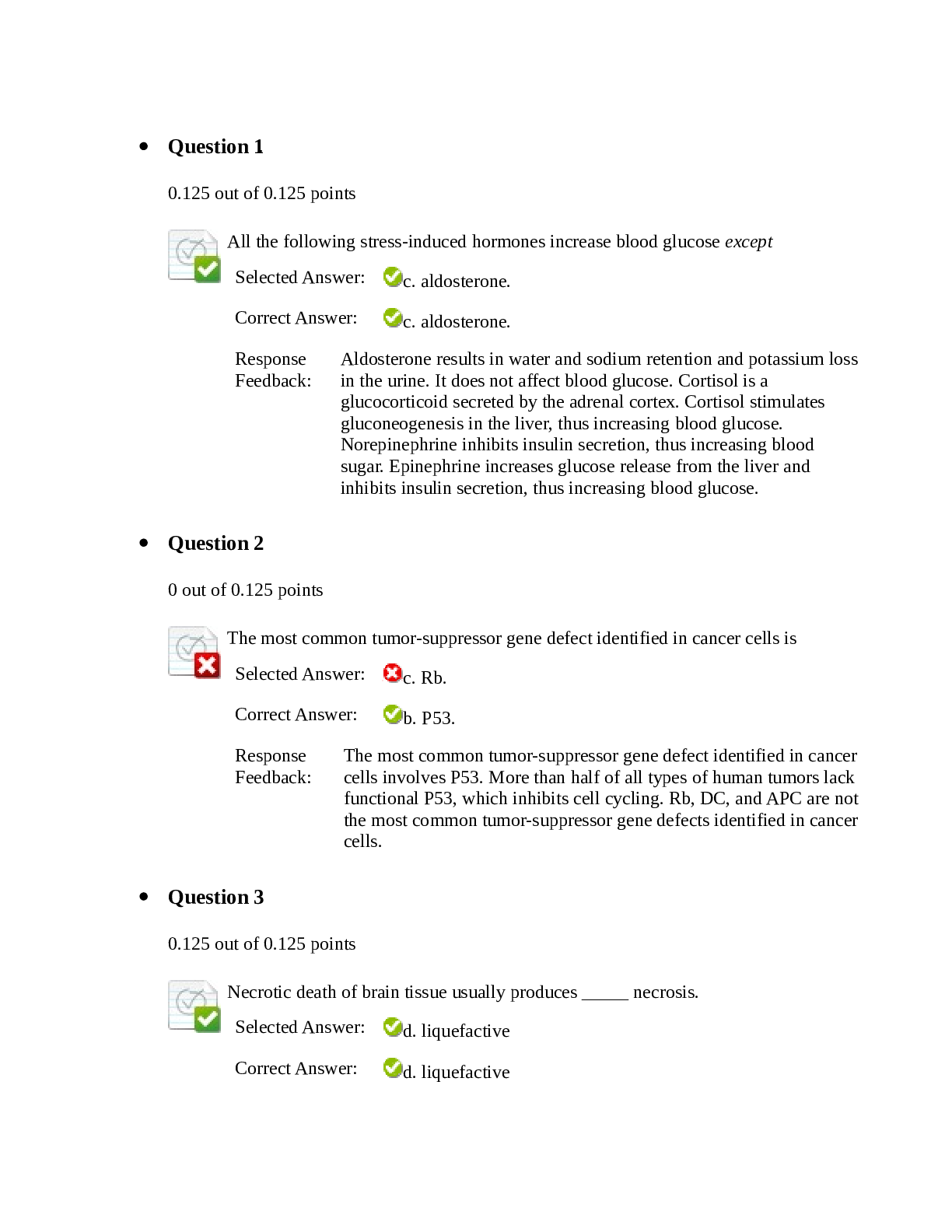*NURSING > EXAM > NURS 190 PHysical Assessment. FINAL Exam. 100 Q&A. Already Graded A+. West Coast University (All)
NURS 190 PHysical Assessment. FINAL Exam. 100 Q&A. Already Graded A+. West Coast University
Document Content and Description Below
PA Final 1. The nurse is caring for a client who was admitted to the medical unit. The nurse notes in the physical exam done by the physician that the client has a positive Romberg. When meeting el... imination needs for this client, the nurse would perform which of the following interventions? A. obtain an order for a catheter B. limit fluid intake C. obtain a bedside commode D. allow the client to walk independently 2. The nurse observes drainage from a client’s ears after a head injury, and suspects a cerebral spinal fluid (CSF) leak. The nurse would document which of the following descriptions of the drainage? A. blood-tinged without sediment B. pink without sediment C. yellow without sediment D. clear, colorless 3. The nurse is performing a neurological assessment on a client and needs to use seterognosis. Which of the following instructions would the nurse provide for the client? A. “Identify the number being traced in your hand with your eyes closed.” B. “Identify the object in your hand with your eyes closed.” C. “Tell me if you feel one or two objects touching you with your eyes closed.” D. “Open and close your hand each time I tell you to.” 4. The nurse notes fanning of the toes when the sole of the foot is stimulated during assessment of the plantar reflex. The nurse would correctly chart which of the following? A. Brudzinski sign B. nuchal rigidity C. hyperreflexia D. Babinski response 5. The nurse is assessing a female client and notes facial hirsutism. The client asks the nurse why this has happened to her. The nurse would correctly respond with which of the following statements? A. “Your diet is not nutritionally balanced.” B. "You need to take vitamins.” C. “There is not a known cause for this condition.” D. “You may have some hormone imbalances.” 6. The nurse is assessing the patellar reflex on a client and obtains no reflective activity. The client is alert and oriented. The nurse should do which of the following in this situation? A. look at the medication records for central nervous system depressants B. retest the reflex after having the client use distraction during the exam C. notify the physician immediately D. document the findings as normal 7. The nurse is caring for a client that insists on having their food very hot and very cold at each meal. The nurse correctly recognize this as a health belief in which of the following cultural groups? A. Chinese Americans B. Native Americans C. Cuban Americans D. Jewish Americans 8. The nurse is caring for a client who is a long-time smoker and notes clubbing of the fingers. The nurse utilized which of the following techniques to validate this assessment? A. place two of the same fingers from each hand together B. place the hands out straight with the palm sides down C. place two index fingers together tip to tip D. place two thumbs touching side by side 9. A 24-year-old client reports difficulty with near vision during an interview with the nurse. The nurse realizes the finding is consistent with: A. hyperopia B. presbyopia C. astigmatism D. aging 10. The nurse is performing a neurological assessment on a client experiencing anosmia. The nurse would suspect cranial nerve involvement in which of the following? A. trigeminal, cranial nerve V B. trochlear, cranial nerve IV C. olfactory, cranial nerve I D. oculomotor, cranial nerve III 11. The nurse is assessing the visual fields of a 38-year-old female who reports recent changes in visual abilities. Which of the following statements would be appropriate for the nurse to use with this client? A. “These changes are probably related to your age.” B. "It is possible you have taken narcotics recently?” C. “The changes could be related to increased pressure within your eye.” D. “These changes require a prescription for glasses.” 12. The nusse assesses a client and finds that a grating sound is present when a joint is bent and straightened. The nurse would correctly document this finding as which of the following? A. joint noise B. grating C. crepitation D. grinding 13. The nurse is planning care for a client with hypothyroidism. Which of the folliwng would be the priority nursing diagnosis for this client? A. altered nutrition, less than body requirements B. risk for constipation related to metabolic imbalance C. risk for injury related to confusion and lethargy D. activity intolerance related to fatigue 14. The nurse is assessing the pulses of a client and palpates the area behind the client’s knee. The nurse would choose which of the following names to document this pulse? A. radial B. brachial C. popliteal D. dorsalis pedis 15. The nurse is assessing cranial nerve XI (spinal accessory). Which of the following statements would the nurse use to the client? A. “Smell these items and identify what they are.” B. “Shrug your shoulders and turn your head against my head.” C. “Stick out your tongue and move it from side to side.” D. “Taste these foods and decide which is sweet and which is sour.” 16. The nurse is caring for a client with Hepatitis A when the client asks the nurse how the illness is contracted. The nurse would respond with which of the following? A. “You must have gotten it from your blood transfusion.” B. “Have you traveled out of the country?” C. “Why are you asking?” D. “It comes from contaminated food.” 17. When assessing the cardiac system of a healthy adult, the nurse would expect to hear which of the following heart sounds? A. S2 then S3 B. S1 then S2 C. S3 then S4 D. S2 then S1 18. The nurse notes swelling and tenderness of the olecranon process during palpation. The client’s chief complaint is pain upon movement of the forearm and wrist. The nurse would correctly suspect which of the following conditions in this situation? A. epicondylitis B. crepitus C. bursitis D. arthritis 19. The nurse is preparing a seminar on Alzheimer’s disease for a group at a Senior Action Center. The nurse would include which of the following information in this session? (Select all). A. incidence increases with age B. may be caused by a virus C. occurs more commonly in men D. causes memory loss and disorientation 20. The nurse is preparing to assess a client’s spine for abnormalities. The nurse would ask the client to do which of the following to perform this assessment? A. bend over, stand tall, and stretch arms over the head B. stand, bend back slowly, then to the right and left while the nurse looks from the back C. lie down on the abdomen so the nurse can look at the back more carefully D. sit down, then stand as the nurse looks from the front of the client 21. The nurse has assessed a client and notes diminished reflexes. The nurse would correctly document which of the following? A. 4+ B. 3+ C. 2+ D. 1+ 22. The nurse is assessing a client with complaints of back pain, possibly related to sciatic nerve involvement. Which of the following findings would support this diagnosis? A. pain with sitting B. pain with leg raises C. pain with adduction D. pain with abduction 23. The nurse instructs a client to walk heel-to-toe, then on toes, and last on heels. The nurse is assessing the function of the which of the following? A. brainstem b. cerebellum C. mid brain D. cerebrum 24. After assessing the client with complaints of hearing loss, the nurse suspects conductive hearing dysfunction. The nurse would correctly choose which of the following tests to confirm this? A. audiometry B. Rhinne test C. otoscopy D. Weber test 25. In the cardiac assessment of a 78-year-old client with no history of cardiovascular disease, the nurse hears a soft sound directly before S1, at the apex of the heart with the bell of the stethoscope. There is no change in this sound with position or respirations. The nurse would implement which of the following actions for this client? A. notify the physician emergently as this is always an abnormal finding B. document the finding as normal in older adults C. monitor fluid status closely due to ventricular volume overload D. obtain a 12 ECG as this is consistent with dysrhythmias 26. The nurse is preparing to compete a musculoskeletal examination on a client. Which of the following assessment techniques would the nurse plan to utilize during the examination? (Select all). A. auscultation B. inspection C. percussion D. palpation 27. The nurse is caring for a client with a knee injury that has returned from surgery for repair. The nurse would correctly identify the knee as which of the following joint types? A. saddle B. pivot C. plane D. hinge 28. The nurse is interviewing a client who reports abdominal pain and belching at bedtime. The nurse should include which of the following questions as a priority in the interview? A. “Are you ever constipated at night?” B. “Do you overeat at night?” C. “Do you take antacids?” D. “How soon after eating do you go to bed?” 29. The nurse is teaching self-breast examination to a client and demonstrates inspecting the breasts with arms over the head. The client asks the nurse why this is necessary. The nurse would respond with which of the following? A. “This is the best position to look for skin dimpling.” B. “this is the only position to detect Paget’s disease.” C. “It is the only way to look for nipple retraction.” D. “It allows any masses to bulge forward to be seen.” 30. The nurse is admitting a client with constant, severe flank pain, spasms, nausea and vomiting, and oliguria. The client states that the pain was initially intermittent and radiated from the low back to the lower quadrants of the abdomen. The nurse’s next action is to: A. notify the physician immediately B. obtain a urine specimen for culture C. complete the assessment D. administer pain medication 31. The nurse is assessing a client with a suspected femur fracture. Which of the following findings would support this diagnosis? A. limited hip internal rotation B. external rotation of the lower leg and foot C. internal rotation of the lower leg and foot D. limited hip external rotation 32-48 question/answer pictures damaged 49. The nurse is auscultating breath sounds on an adult client and hears crackling sounds over most of the chest. Which of the following would be the best action for the nurse to take next? A. wet the hair before auscultating the chest B. switch from the diaphragm to the bell C. document this as abnormal D. ask the client to cough, then auscultate again 50. A client arrives in the ER with complaints of intermittent nosebleeds for the past two days. Which of the following assessments would be a priority for the nurse in this situation? A. check for deviated septum B. obtain a blood pressure C. check stools for blood D. obtain nasal cultures 51. The nurse is assessing a client with a left-sided weakness and notes a loud, blowing sound over the right carotid artery. The nurse would suspect which of the following disorders? A. tricuspid stenosis B. carotid stenosis C. left ventricular failure D. right ventricular hypertrophy 52. The nurse is performing a neurological assessment and needs to test cranial nerves. The nurse asks the client to close both eyes and report when a touch with a wisp of cotton is felt. The nurse is assessing the function of which of the following cranial nerve? A. optic nerve, cranial nerve II B. trigeminal nerve, cranial nerve V C. facial nerve, cranial nerve VII D. abducens nerve, cranial nerve VI 53. The nurse is preparing a neurological health seminar for the staff on the unit. Which of the following statements would the nurse include in the teaching plan? A. Alcohol or drug use increases the risk for accidents and injury B. Older adults experience fewer accidents and injury C. Epilepsy only occurs in children under age 15 D. Head injuries are more common in adults than children 54. The nurse is interviewing a client with suspected Lyme’s disease. Which of the following questions would be a priority in this situation? A. “Have you been hiking or camping lately?” B. “Do you have an appetite?” C. “When was your last seizure?” D. “What has your temperature been running?” 55. The client’s chief complaint in inability to move the fourth and fifth fingers during the nurse’s interview. The nurse notes severe flexion in both of the affected fingers and upon palpation, but there are no complaints of pain from the client. The nurse would suspect which of the following conditions in this situation? A. Dupuytren’s contracture B. bursitis C. osteoarthritis D. carpel tunnel syndrome 56. The nurse notes asymmetry of the iliac crests and gluteal folds while inspecting the spine of a client. The client’s spine has a slight curvature to the right, but denies complaints of pain. The nurse would correctly document which of the following choices? A. muscle spasms B. spinal list C. scoliosis D. compression fracture 57. The nurse asks the client to pull the toes up towards the nose during an examination of the lower extremities. The nurse is assessing which of the following movements? A. plantar flexion B. dorsiflexion C. eversion D. inversion 58. The nurse is admitting a client with suspected meningitis and notes a positive Brudzinski’s sign has been noted in the history and physical. To validate this assessment finding, the nurse would note which of the following? A. neck extension B. flexion of the legs and thighs C. seizure activity D. neck pain and stiffness 59. The nurse is palpating the knee of a client and uses firm pressure to stroke the medial aspect of the knee upward while applying pressure to the lateral side and observing the medical side. The client has expressed pain and immobility in the area. The nurse is using which of the following tests? A. ballottment B. bulge sign C. palpation D. inspection 60. The nurse is assessing a client with suspected rheumatoid arthritis. Which of the following musculoskeletal changes would contribute to a positive diagnosis? (Select all). A. Swan-Neck deformity B. Heberden's nodes C. ulnar deviation D. Bouchard’s nodes 61. The nurse is educating a group of older adults on urinary health. Which of the following would be important for the nurse to include for this group of clients? A. limit fluids throughout the day B. eat high amounts of potassium C. drink fluids even if not thirsty d. increase medication dosages 62. The client with a 30-year history of cigarette smoking is being assessed by the nurse. The client reports past medical history of peripheral vascular disease, and is obese and has a sedentary lifestyle. Which of the following would be a priority for the nurse to include in this client’s teaching plan? A. exercise is vital B. nicotine primarily affects coronary arteries and the lungs C. nicotine is a vasoconstrictor D. obesity is a factor in cardiovascular, but not peripheral vascular disease 63. The nurse is assessing a client admitted to the hospital for congestive heart failure and notes nonpitting edema of the left arm, as well as bilateral 1+ ankle edema. The client’s history is positive for a myocardial infarction and left mastectomy. The nurse would suspect which of the following causes for the edema in the left arm? A. impaired lymphatic drainage B. excessive intake of sodium C. right sided heart failure resulting from left sided failure D. noncompliance with medication regimen 64. The nurse is percussing the anterior chest of an elderly client. Which of the following would the nurse expect to find in this client? A. flatness B. tympany C. hyperresonance D. dullness 65.The nurse is assessing a client with reports of a sudden onset right lower quadrant pain. The nurse obtains a positive psoas sign, which would lead the nurse to suspect which of the following? A. obstruction B. appendicitis C. constipation D. cholecystitis 66. The nurse is admitting a client with suspected meningitis. During the assessment, the nurse asks the cient to flex the chin down towards the chest. The client verbalizes pain and stiffness during this action. The nurse would document this as which of the following? A. muscle spasms B. decortication C. neck strain D. nuchal rigidity 67. The nurse is perofmring reflex testing on a client uses the reflex hammer to gently strike the forearm about two inches above the wrist. The nurse is assessing which of the following reflexes? A. biceps B. brachioradialis C. triceps D. Achilles 68. A client has a spinal cord injury with paralysis at C5 level. When completing discharge teaching, which of the following client statements would require further teaching? A. “I need to avoid bladder distention.” B. “I need to perform self-catherization three times daily.” C. “I know I cannot look to see if any bladder is full.” D. “I’ll drink adequate amounts of liquids.” 69. The nurse is obtaining a health history from a client who reports that they are healthy and has no health concerns. As part of the health history, the nurse documents that the client reported that they have high BP and suffer from a leg ulcer that remains unhealed after 6 months. Which of the following statements would be the best choice for the nurse to use at this point in the interview? A. “Do you understand what hypertension is?” B. “I feel that you may be in denial about your health status.” C. “Is there anything else you are not telling me?” D. “Tell me about your definition of being healthy.” 70. The client’s chief compliant is pain in the foot. The nurse notes a deviation of the great toe from the midline and crowding of the remaining toes. There is enlargement and inflammation noted in the area. The nurse would suspect which of the following conditions in this situation? A. hammertoe B. flat foot C. bunion D. gouty arthritis 71. The nurse is discharging a client with osteoarthritis. Which of the following would the nurse include in the teaching plan? (Select all). A. Smoking and alcohol contribute to the development of osteoarthritis B. Musculoskeletal health is influenced by the diet C. Obesity increases the risk of bone, muscle, and joint disorders D. Exercise is important in the prevention of osteoarthritis 72. Upon inspection of a client’s knee, the nurse notes swelling, heat, and redness of the anterior aspect of the knee. The client reports pain in the area. The nurse would suspect which of the following conditions in this situation? A. degenerative disease B. osteoarthritis C. torn meniscus D. prepatellar bursitis 73. The nurse is assessing a client that experienced a head injury and assigns a Glascow Coma Scale rating of 3. The nurse would correctly note which of the following for this client? (Select all). A. no verbal response B. no motor movement C. no response with eyes D. pupil response sluggish 74. The nurse is performing a cardiac assessment and needs to locate the point of maximal impulse. Which of the following locations would the nurse choose to locate this? A. third intercostal space, left sternal border B. second intercostal space, right sternal border C. second intercostal space, left sternal border D. fifth intercostal space, midclavicular line 75. A young adult is seen in the clinic complaining of a lump the left wrist, but states it is not painful. The nurse notes a round mass on the back of the wrist. The nurse would suspect which of the following? A. carpal tunnel syndrome B. rheumatoid arthritis C. osteoarthritis D. ganglion 76. The nurse is reviewing a client’s medical records and notes various forms of information. The nurse understands that which of the following is subjective data? A. laboratory analysis reports B. results of radiographic studies C. physical examination results D. symptoms described by the client 77. The nurse is interviewing a client that states they do not have any feeling on right side of the body. After confirmation of this subjective data, thenurse would correclt document which of the following? A. analgesia B. hypoesthesia C. hypalgesia D. anesthesia 78. The nurse is observing a client’s ambulation abilities and notes a higher than normal leg raises and a flopping of the foot with each step. The nurse would document this gait as which of the following? A. scissors B. ataxis C. festination D. steppage 79. The nurse is caring for an elderly client. The nurse would expect which of the following musculoskeletal changes? A. difficulty with dexterity B. pain when ambulating C. risk for fractures D. increased bone production 80. The nurse is admitting a client with a shoulder dislocation. The client asks the nurse what this diagnosis means. The nurse would respond with which of the following statements? A. “Your shoulder is fractured and separated from the joint.” B. “You have a muscle tear at your shoulder.” C. “I cannot tell you without your doctor’s permission.” D. “Your shoulder bone has come apart from the shoulder joint.” 81. The nurse is preparing to assess a client’s abdomen. Which assessment technique should this nurse use last during this examination? A. palpation B. percussion C. inspection D. auscultation 82. The nurse is preparing several clients in the clinical setting. Which of the following clients would need the greatest degree of special consideration during physical examination? A. fifty-nine-year-old with influenza B. seventeen-year-old who complains of fatigue C. three-year-old child in for a well check-up D. sixty-eight-year-old with COPD 83. The nurse is assessing a client complaining of wrist pain. Upon examination the pain occurs when resistance is produced against the wrist. The nurse would correctly suspect which of the following conditions in this situation? A. bursitis B. crepitus C. medical epicondylitis D. rheumatoid arthritis 84. The nurse is examining a client with a chief complaint of pain in the right great toe. The nurse notes hardened nodules on the lateral aspect of the toe, as well as redness and swelling. The nurse would suspect which of the following? A. hammertoe B. bunion C. gout D. synovitis 85. The client’s chief complaint is numbness and tingling in the hands when interviewed by the nurse. The client complains of numbness and tingling in the arms when bending the wrist downward and pressing the backs of the hands together. The nurse would suspect which of the following conditions in this situation? A. Dupuytren’s contracture B. arthritis of the wrists C. carpel tunnel syndrome D. crepitus of the wrists 86. The nurse is observing a client’s ambulation abilities and notes a scissors gait. The nurse would suspect which of the following disorders in this client? A. myasthenia gravis B. Parkinson’s disease C. multiple sclerosis D. muscular dystrophy 87. The nurse is interviewing a client with dysphagia after a recent cerebral vascular accident. The nurse would use which of the following cranial nerve tests to support this finding. (Select all that apply.) A. ask client to protrude the tongue B. observe voice for hoarseness C. use tongue blade to depress tongue D. test gag reflex 88. The nurse is presenting a workshop on health vision to a group of optometry students. The nurse would include which of the following as the leading cause of blindness in the United States? A. diabetic retinopathy B. cataracts C. environmental pollutants D. glaucoma 89. The nurse is assessing the musculoskeletal system of a client and notes hard knots along the back muscles bilaterally. The nurse would suspect which of the following in this situation? A. compression fracture B. spasmodic torticollis C. scoliosis D. muscle spasms 90. The nurse is caring for an elderly client. The nurse would expect which of the following bone changes? A. decreased calcium absorption B. no bone changes would be noted C. increased osteoblastic activity D. increase in bone density 91. The nurse is palpating the spleen of a client with infectious mononucleosis. The nurse should note which of the following bone changes? A. this should be done carefully B. must be done with light followed by deep palpation C. must be performed with the client’s breath held D. there may be pain 92. The nurse working in a predominately Hispanic community outlines a breast health screening. The nurse is aware that: A. Hispanic woman have a higher incidence of breast cancer after age 40 B. breast cancer is the leading cause of cancer death in Hispanic women C. this cultural group is strict about performing monthly self-exams D. Hispanic woman have an open attitude about private issues 93. The nurse is caring for a client with a right femur fracture that has returned from surgery for repair. The nurse would correctly identify the femur as which of the following bone types? A. irregular B. long C. flat D. short 94. The nurse is assessing a client to determine tremors associated with Parkinson’s disease. The nurse would correctly observe for which of the following movements? A. rhythmic shaking B. athetoid movements C. fasciculations D. chorea 95. The nurse is using inspection to assess the breasts of a female client. Which of the following findings might the nurse obtain using the assessment technique? A. skin thickening B. tenderness C. hard nodules D. symmetry 96. The nurse is admitting a newly admitted client and notes skin vitiligo, which is highly visible even from a distance. The client asks you to put a no visitors sign on the door and has called the family to tell them not to visit. Which of the following nursing diagnosis would the nurse identify as a positional problem? A. defensive coping B. deficient knowledge C. disturbed body image D. risk for loneliness 97. The nurse is performing a neurological assessment and needs to assess for vibration, as well as sharp and full sensation. The nurse would use which of the following objects to elicit this information? (Select all). A. paper clip B. safety pin C. cotton ball D. tuning fork 98. The nurse notes a grating sound when examining the knee joint. The nurse would correctly document which of the following choices? A. limited motion B. knee deformity C. crepitus 99. The nurse is assessing a client’s ambulation abilities and notes a stooped posture with short, stuff steps. The nurse would document this gait as which of the following? A. fesintation B. steppage C. ataxic D. scissors 100. The nurse is interviewing a client and notes that the left eyelid is drooping. The nurse would correctly chart which of the following conditions? A. nystagmus B. ptosis C. strabismus D. myopia [Show More]
Last updated: 9 months ago
Preview 1 out of 12 pages
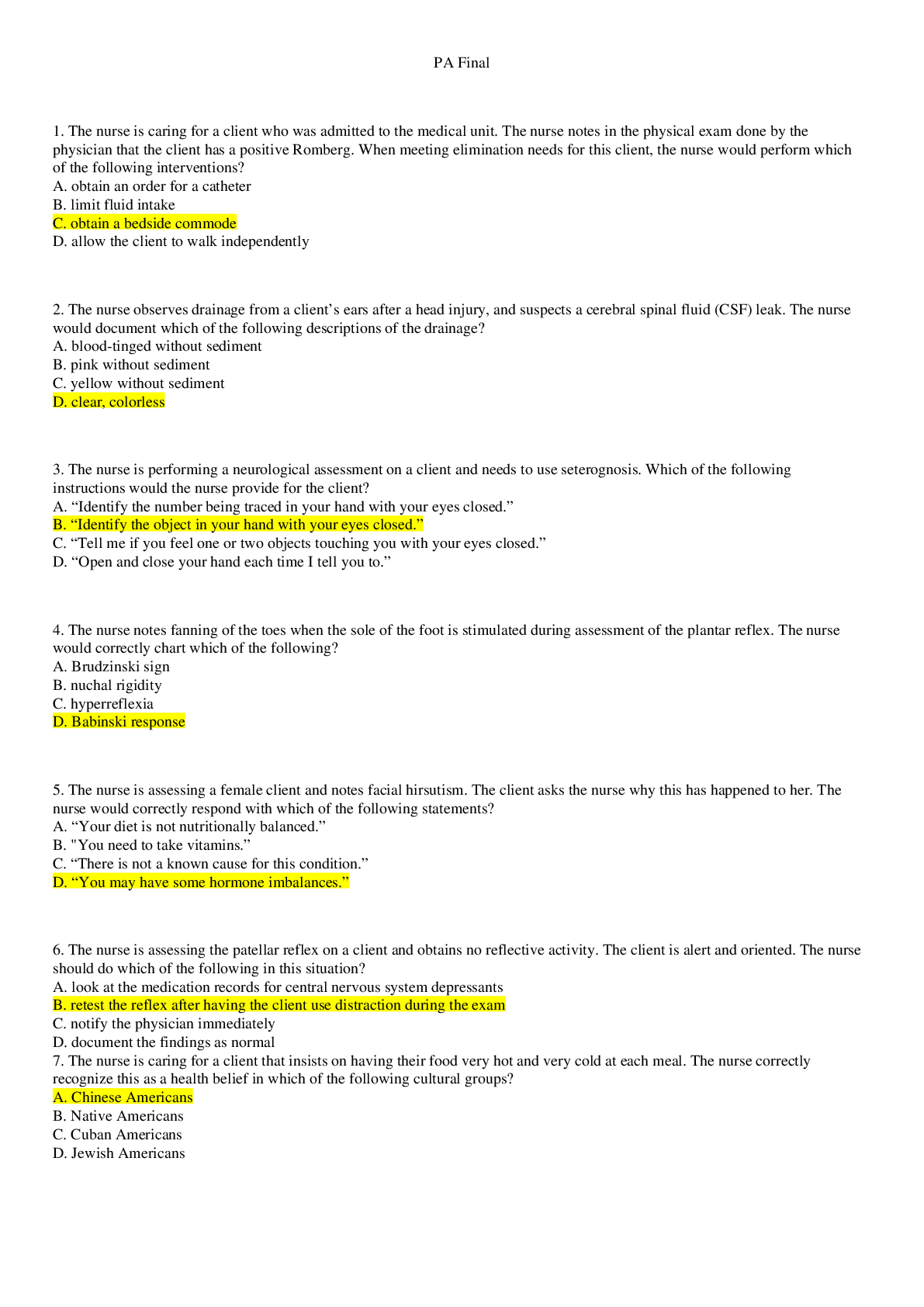
Reviews( 0 )
Document information
Connected school, study & course
About the document
Uploaded On
Oct 07, 2019
Number of pages
12
Written in
Additional information
This document has been written for:
Uploaded
Oct 07, 2019
Downloads
1
Views
99

